
The idea of this trip came from a few ladies in a Meetup group that I’d joined last year. We decided we’d like to travel together for a few days, somewhere within easy reach. We all put forward a list of choices and we decided upon Amsterdam. Unlike the others I’d never been to Holland. When I’d lived in England before moving to the U.S we’d always spent vacations in far away, exotic places, knowing that we’d be more comfortable travelling to places closer to England when we were older . . . little did we know that I’d end up living in the U.S for 32 years . . . but now that I’ve moved back to England here’s a wonderful opportunity to visit those places closer to home.
DAY 1
And just how close is Amsterdam from where I live now? Well, I had breakfast at home in Hebden Bridge, and elevenses in Holland! We flew together from Leeds/Bradford airport, a 45 minute drive from home, and the flight was 50 minutes. It was a lovely sunny day as we left but I didn’t get much of a view from my aisle seat on the plane either going or coming back home.
Our hotel was in Zaandam, a 20 minute train journey from the airport and only 12 minutes by train from the centre of Amsterdam. I knew that Zaandam was famous for some crazy architecture but that was about the extent of my knowledge. My trip to the U.S and moving apartments a few days after I’d returned had taken up my time and I’d done zero preparation for the Holland adventure.
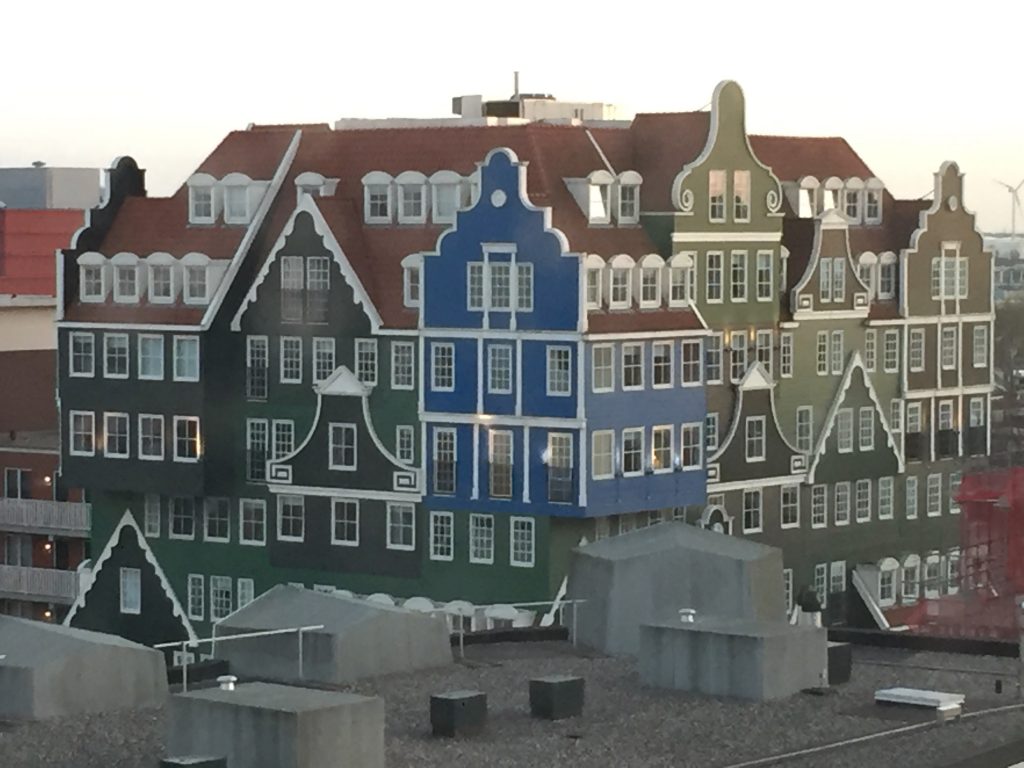
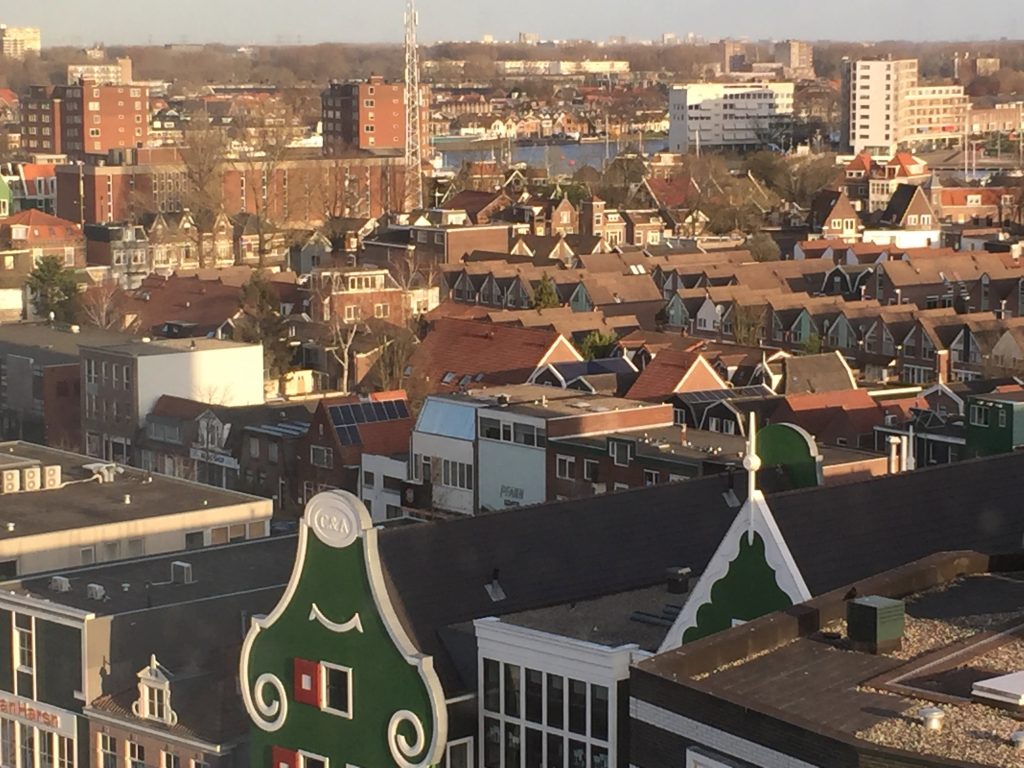
View from my hotel room 
Zaandam street 
High rise, Zaandam style
We checked into Easy hotel which is on the floors above Primark! My room was on the 10th floor and I could see a large portion of Zaandam below me. It’s population is around 76,000 and the amazing thing is that apart from one elevated road in the distance I couldn’t see a single car! But almost every street had its own canal. We went to explore the city with its narrow buildings, all different and brightly colored, though I was surprised by the lack of blooming flowers in the city. I’d seen far more daffodils driving from Hebden Bridge to the airport than I could see in Zaandam. The same comment was to be made in Amsterdam too. We found the town square and parked ourselves in a bar there to people watch but it was rather chilly to sit outside. A large statue of a ship builder dominated the square and I was surprised to see that the name below was written in Russian. I needed to find out why – and who this person was. We found the main sluice gate to the main canal with its ornate stone columns and date stones and a new rusty iron sculpture of a sinking bridge has been added. I even found a Mozartstrasse. What’s Mozart got to do with Zaandam? We had dinner in an Italian restaurant where large black and white portraits of old Italian movie stars decorated the walls. By 9 o’clock we were ready to turn in for the night.
DAY 2
A day in Amsterdam.
We found a little coffee/pancake shop opposite the hotel to have breakfast it it became ‘our’ breakfast place each morning of the trip. It had rained during the night but there was lots of blue sky as we crossed the canal to get our morning tea – but it was decidedly chilly. Nowhere in Holland did we find pots of tea, and since our hotel, though excellent in many other ways, didn’t have a kettle in the room, we were constantly on the look-out for tea as we wandered around all day.
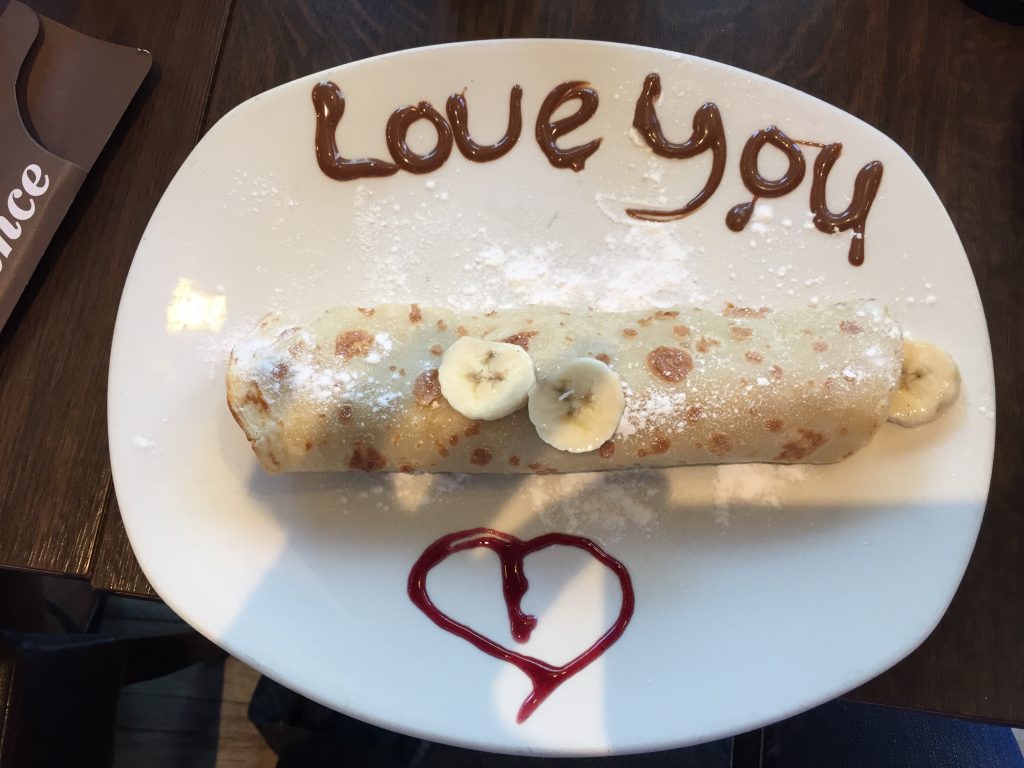
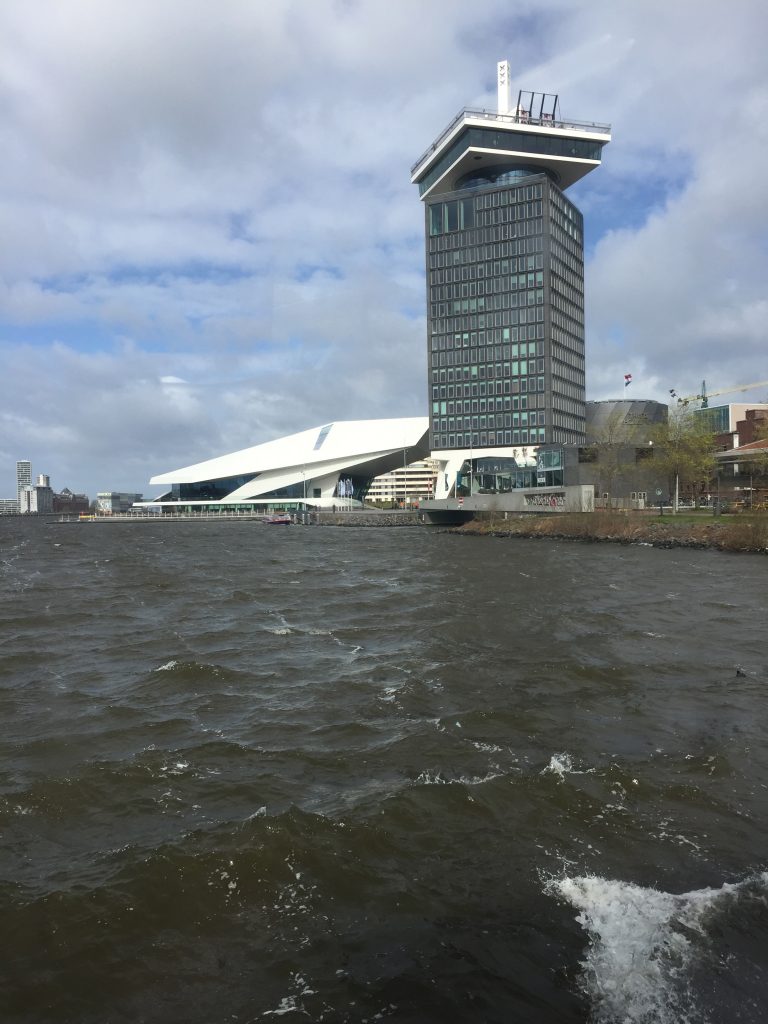
Approaching the A’Dam building by ferry 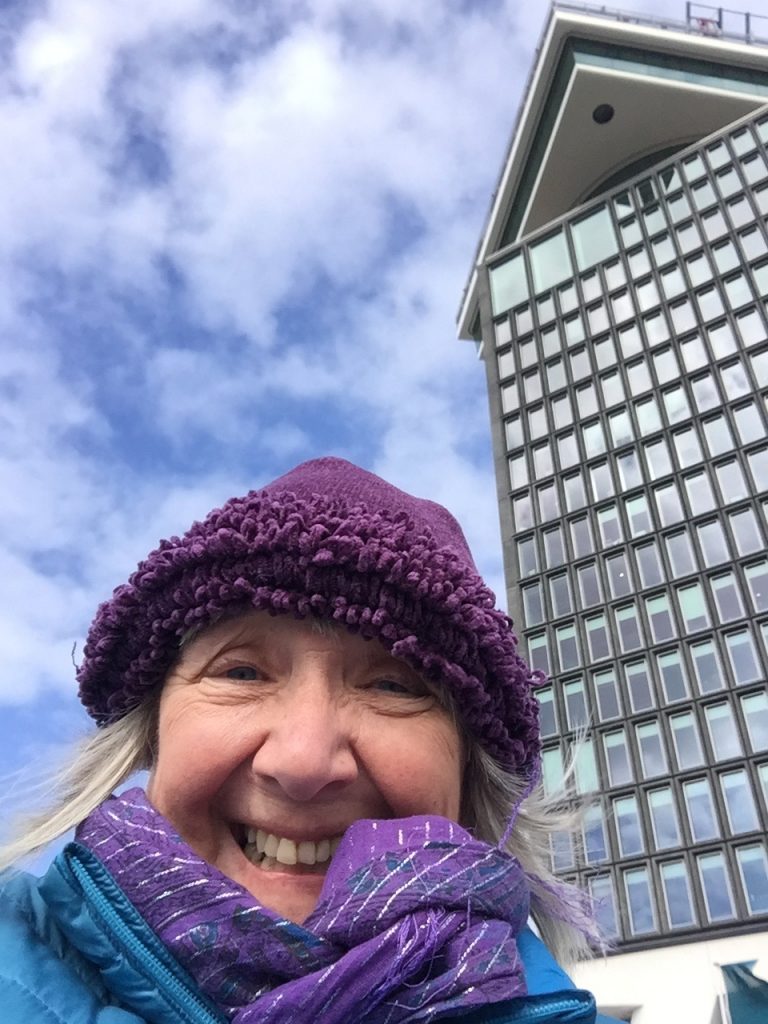
Windy! 
Gibson guitar girl 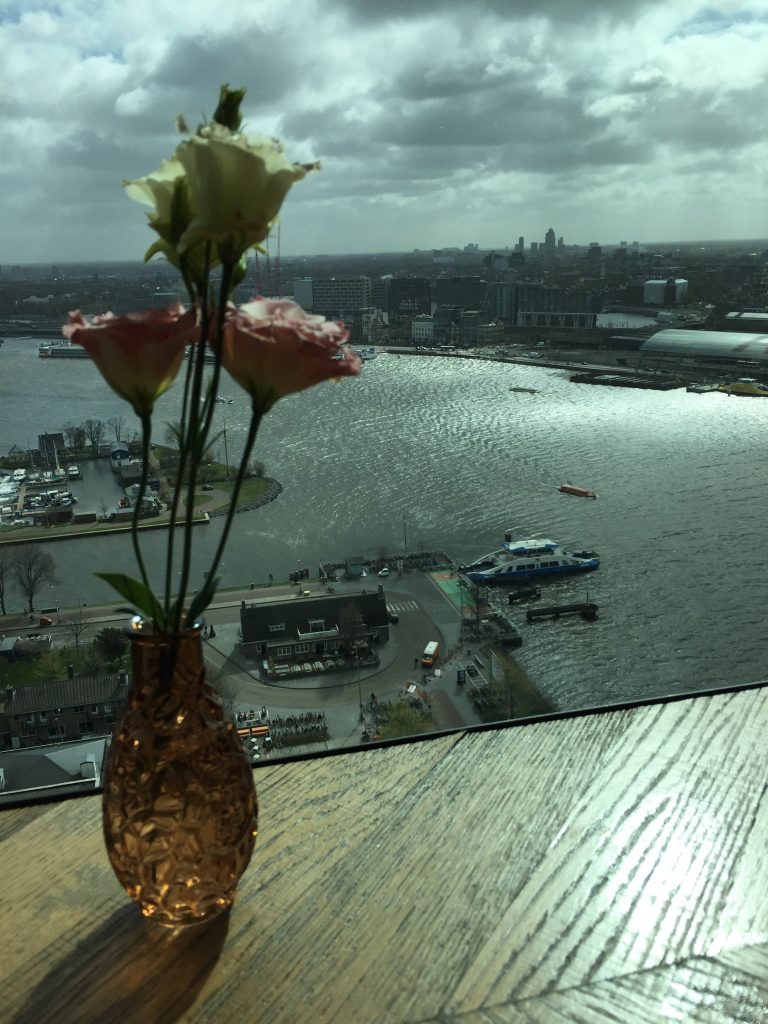
View from the bar 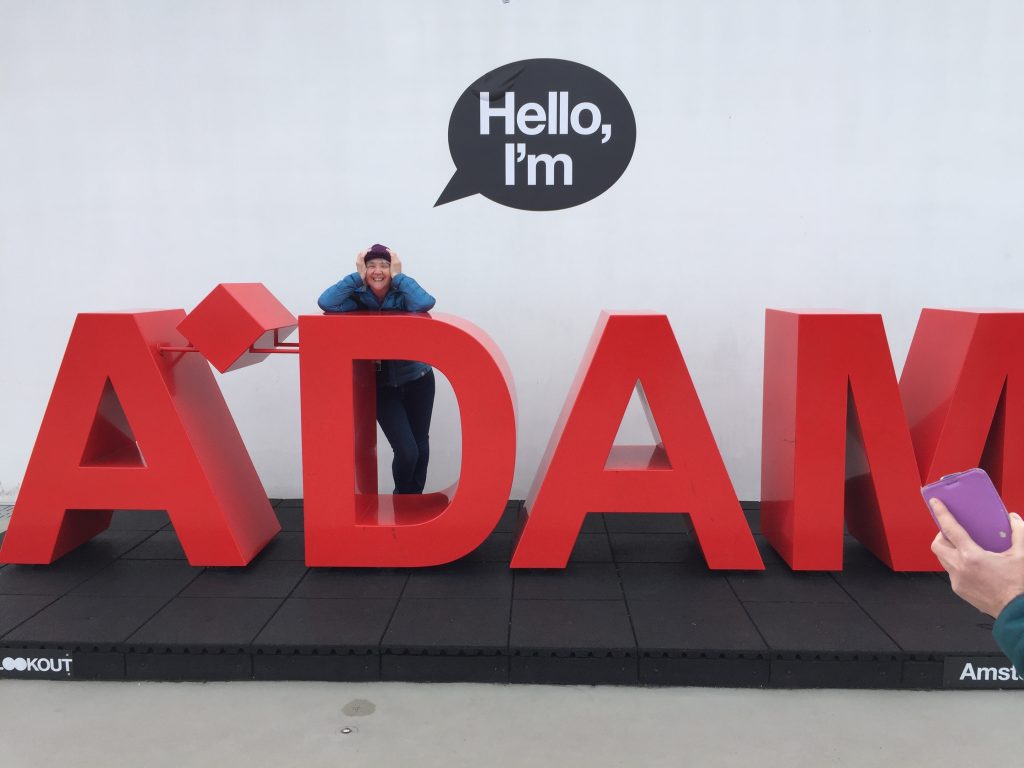
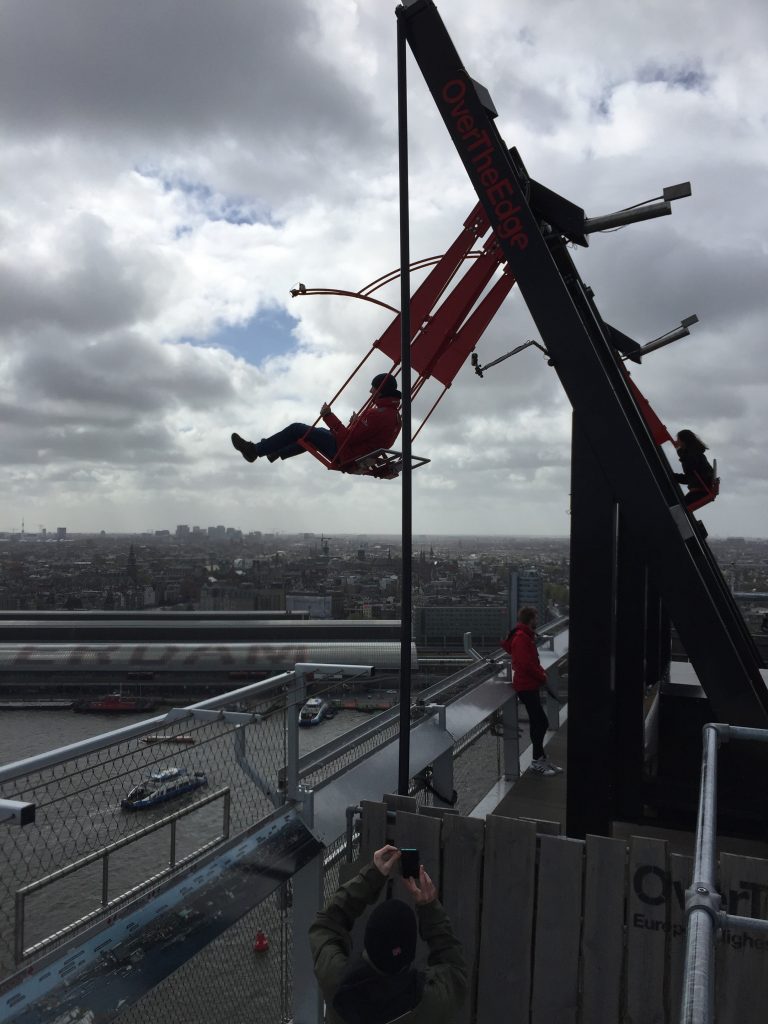
You wouldn’t catch me doing this 
We spent the day in Amsterdam, traveling there by train in 12 minutes from Zaandam. I was excited to step foot in the city but I soon realized that my idea of Amsterdam in my imagination was nothing like the vibrant modern city that I was seeing. It seems primarily a city made up of people in their 20’s but perhaps that can be said of most capital cities, and probably reflects more my age than anything else. Fast moving bicycles were a devil to negotiate, making me realize just how much I rely on my hearing to cross roads normally. Here silent bikes charge towards you, suddenly appearing from around corners at crazy speeds. Dodging between the trams outside the train station also took some skill. Canals were everywhere, not just the four main canals but a veritable fabric of interwoven watery threads bordered by immaculate four story houses painted in beautiful colors but often perched at crazy angles as though they are falling over – and that comment was made before I’d had my first beer at lunch time! Who built them? When? Why? My head was filled with questions. But then, that’s one of the reasons I enjoy traveling to new places.

Leaving the station, where the mirrors on the ceiling had the interesting effect of portraying everyone upside down, taking our life in our hands we crossed the tram tracks, moved swiftly to avoid bicycles and jumped on the free ferry across to the A’Dam centre. It was very, very windy and the water was choppy on the ferry. There seemed to be just as many bicycles as people! The A’Dam tower is a high rise building housing clubs, restaurants, a music school, a lookout tower and a crazy swing that swings you over the edge of the top of the building. Rising 100 meters in 22 seconds, complete with light show, we found ourselves in a bar with spectacular views, but even better was the outdoor platform where the booming sound of the wind was amazing. Several times we were almost blown over, and I couldn’t imagine how the swing was still allowed to operate in such windy conditions.

Heading past 100s, probably 1000s of bikes on racks at the station I found myself wondering how people remember where they’ve parked their bikes. I mean, who hasn’t forgotten which floor they parked their car on in a multi story car park? There are around 880,000 bikes in Amsterdam and on average between 12,000 and 15,000 are pulled out of the canals each year. Amsterdam also has 4 full time divers who are on 24 hour standby to pull out occupants of the cars which fall into the canals – about one per week! The three main canals were built in the 17th century during the Dutch Golden Age when the Dutch were exploring and colonizing many places around the world and were becoming one of the most important trading nations. Even the Tzar of Russia came to learn the tricks of the trade from the Dutch . . . no, not from the famous Red Light district but from their ship building experts. But more of that later.
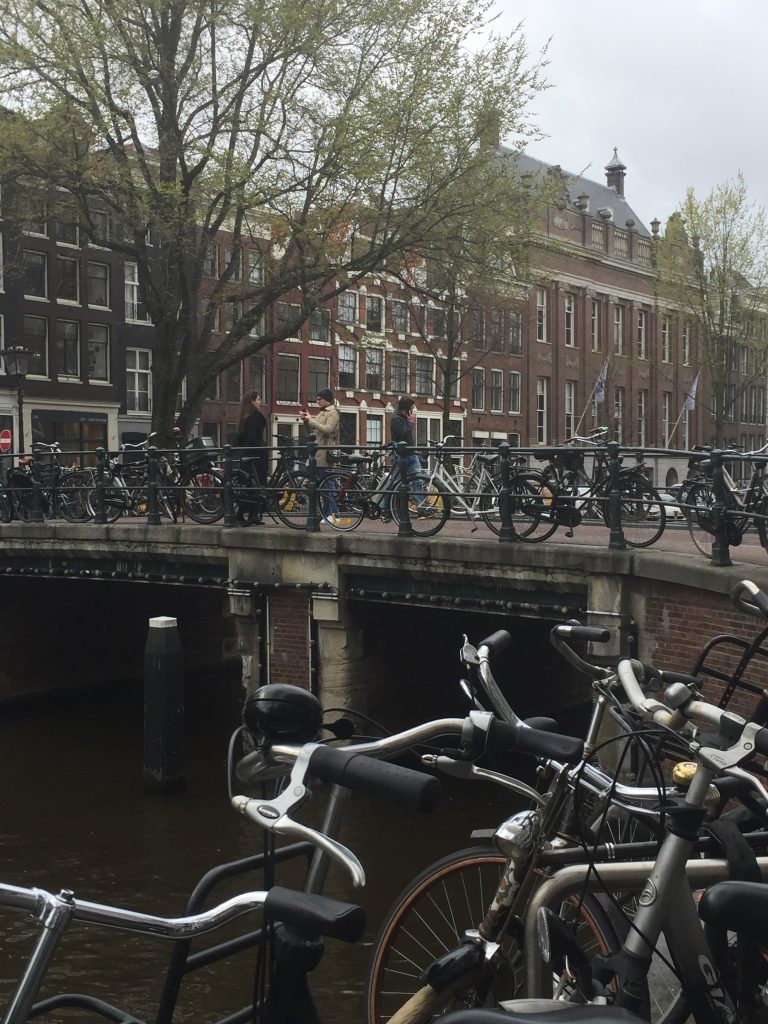
Even Primark had gotten into the spirit of the scenery!
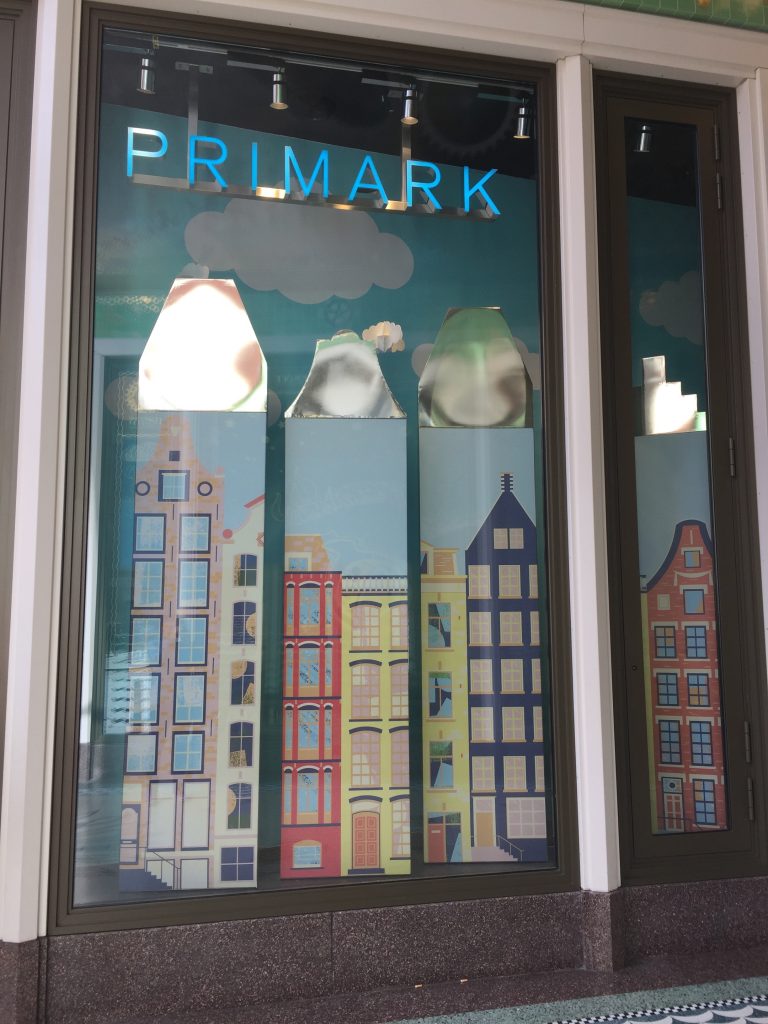
We had lunch in a loverly little cafe bar and continued exploring the large square with their imposing buildings. Most of the paths and squares are surfaced in brick tiles, sometimes in intricate patterns. Apparently because the ground surface is so marshy macadam roads would disintegrate but the brick absorbs the water and makes the paths quiet stable. The same can’t really be said of the oldest houses in the cities. The oldest I saw dated from 1590 but many proudly sported date stones in the 1600’s. To find stable ground to form the foundation of a building wooden poles had to be sunk to find the stable sand and these formed the footings of the buildings. Because stable, dry land was at such a premium buildings tended to haver a space footprint and so extended upwards rather than outwards. Merchants built their warehouse adjacent to their home. Overhanging winches were used to get the wares into the warehouses and apparently these winches are often updated and still used to enable large piece of furniture to be taken up onto the 3rd and 4th floor apartments.
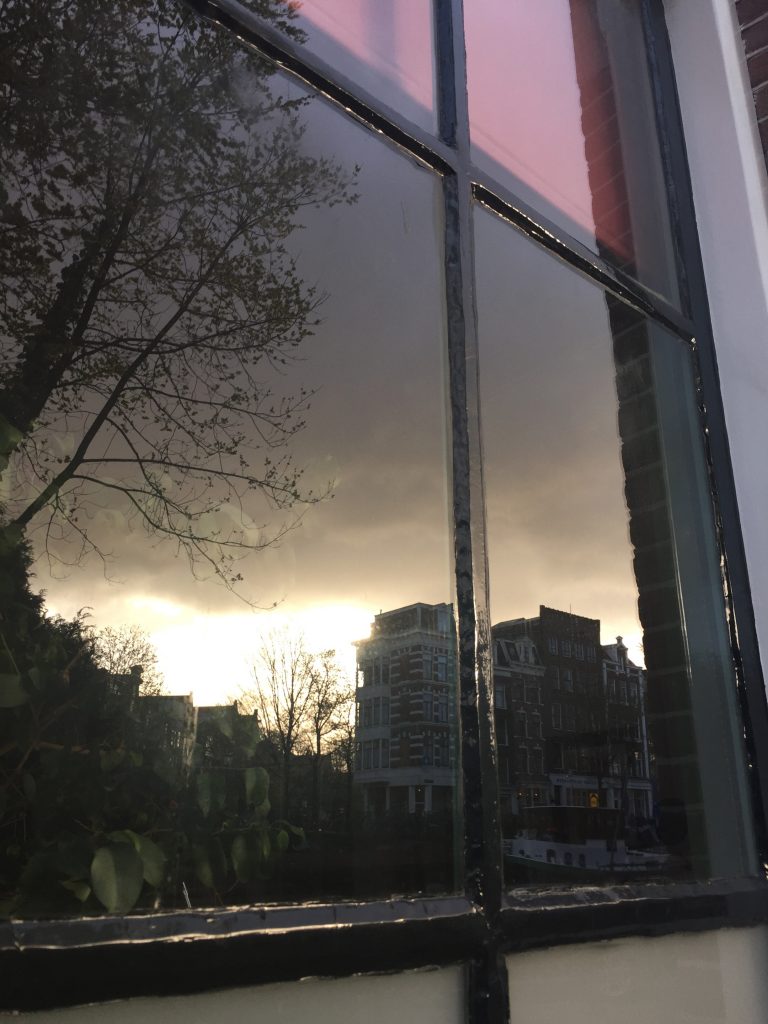
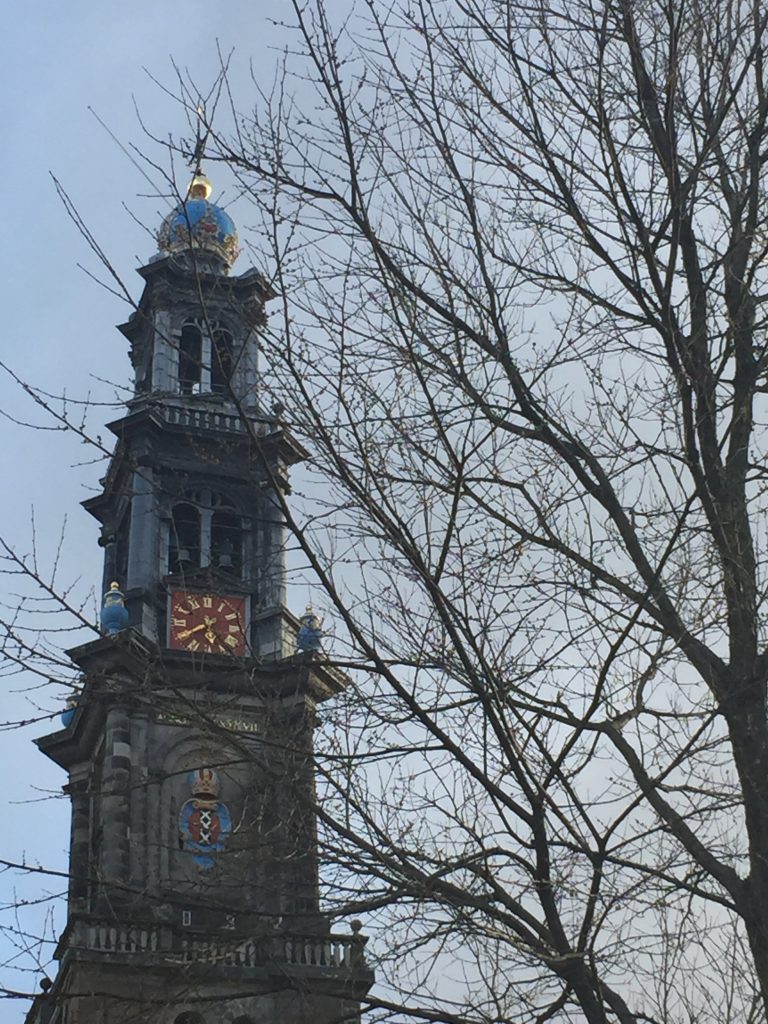
The Prince’s canal was began in 1612 and during the 50 years it took to complete the population of Amsterdam had grown from 50,000 to 200,000 making it the 3rd biggest city in the world after London and Paris. Built in 1630 the Westerkerk has the highest spire in Amsterdam and Rembrandt is buried somewhere in the church although the exact location has been lost.Very close to the church is the Anne Frank house and the spire with its clock face was visible from the attic and Anne described in her diary the chiming of its carillon as a source of comfort. There is a photo in Anne’s house of the Nazi troupes driving right past the church.

We’d booked our tickets to Anne Frank’s house before we left England and we had been lucky to get tickets at such short notice. We’d got the final time slot of the day, yet even so it was packed. I’ve never read her diary, but Anna had visited the house a few years ago so I knew it was worth going to. I think the thing that made the biggest impression on me was the silence. Yes, everyone was given a listening commentary and so everyone was intent on listening to the commentary so no-one was chattering to their friends and family. The journals Anne kept reminded me so much of my journals which I wrote at around the same age – and still have – filled with little sketches. The posters that her father had put on her wall I found very poignant. Only Anne’s father Otto, survived out of the 8 people who were in the house, and I found his interview much later in his life very hard to watch.
We’d planned on having dinner in the Grand cafe at Amsterdam’s grand central station situated in the former 1881 waiting room with impressive Art Nouveau decor. We hadn’t made reservations and we were fortunate to get a table, but it was very busy and when I asked our waiter to take a photo of us enjoying our meal he told is flatly that no, he was too busy. We had already noted and commented on the rather brusque service we’d had in several cafes and bars and I read an interesting interpretation of this characteristic. Holland is flat. The landscape is bare, open. There’s nowhere to hide. Perhaps this accounts for the forthright demeanor of the Dutch: they say it like it is. No gratuitous smile masking the real feeling that is so often the order of the day in other countries. Maybe there’s something in that. One of the more bizarre residents of this restaurant is a white cockatoo by the name of Elvis!
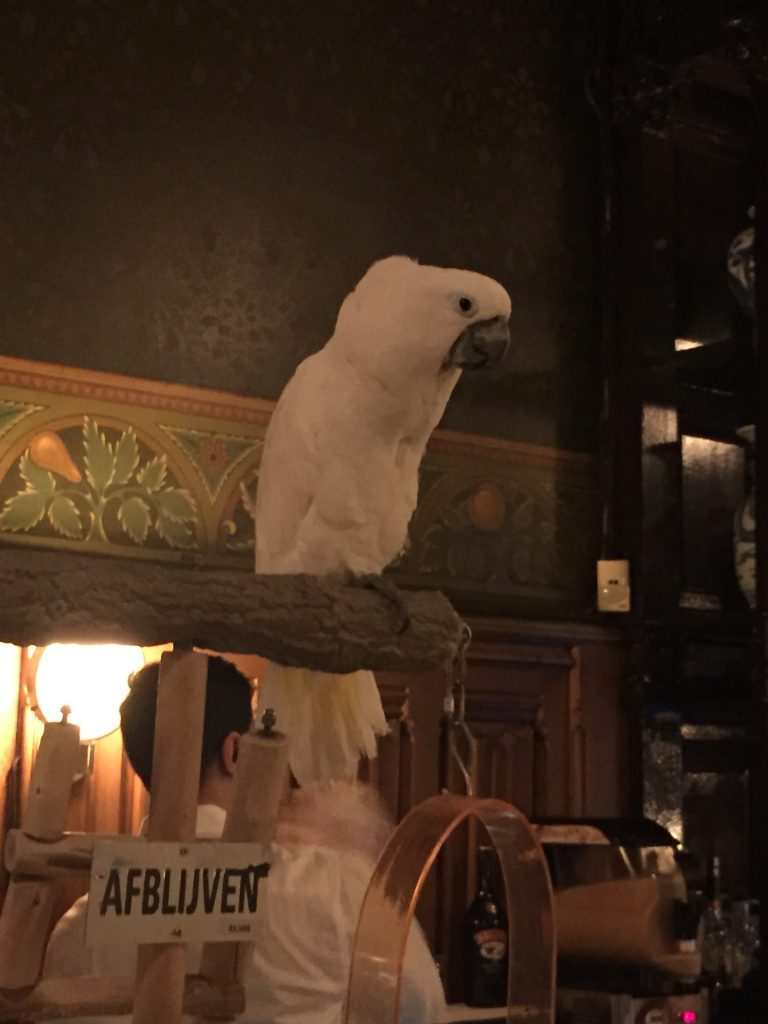
DAY 3
The next morning we were to go exploring rural Holland and we began our day by going to Zaanse Schans where restored and reconstructed windmills still operate, but now primarily for tourists. Our journey didn’t quite work out as we expected since we got off at the wrong station but not to worry. We figured it out. There’s a comfort in being with a group, even when we all get it wrong! Eventually we back tracked on a bus and found a student who was going our way and was happy to walk with us to the village. We had to wait to cross a draw bridge which was just being raised to let a couple of boats through, and then it got stuck going down, but eventually we were able to cross and soon found ourselves confronted by several picturesque windmills. It dawned on me that this is what I’d been expecting in Amsterdam! Yes, crazy, I know, but in my imagination Holland is Monet and Van Gogh’s paintings of the country – pre-industrial revolution. It’s this ubiquitous tulip strewn landscape, dotted with windmills and clog wearing millers that Holland promotes to tourists, and I had fallen for it hook, line and sinker – ha! But now we were firmly in tourist land and I set off to explore by myself arranging to meet the others for lunch later.
I set off along the canal bank to the farthest windmill, stopping to take lots of photos, and ultimately decided on visiting the saw mill that was hard at work. An interesting movie showed the rebuilding of this windmill. So many moving parts – amazingly intricate. The sound of the sawing was interesting too and I stopped to watch the sawdust piling into clear bags in layers. Another of the mills grinds spices and another grinds pigments for paint. One had a date stone of 1667. I was surprised to see that the body of some of the mills were thatched. At the height of its power around 1720 there were 600 mills in this area. Traditionally, the wood processing and food industries have been the most important industries in the Zaan region. In the 17th and 18th centuries, along the banks of the Zaan there were weaving mills, forges and various other processing industries (tobacco, cocoa, paper, paint, candles), but also shipbuilding and maritime shipping were well represented. Almost every village in the Zaan region participated in whaling. In 1697 almost 80 Greenland sailors sailed on the Zaan at the same time, with no fewer than 40,000 barrels of whale bacon!

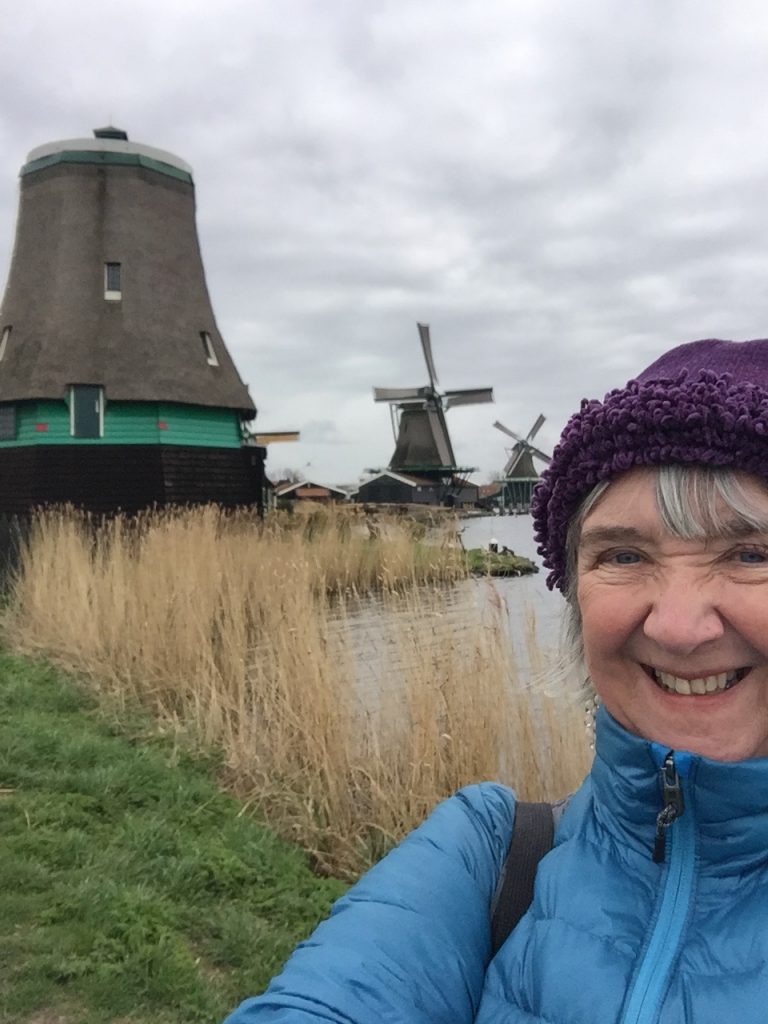
A thatched windmill 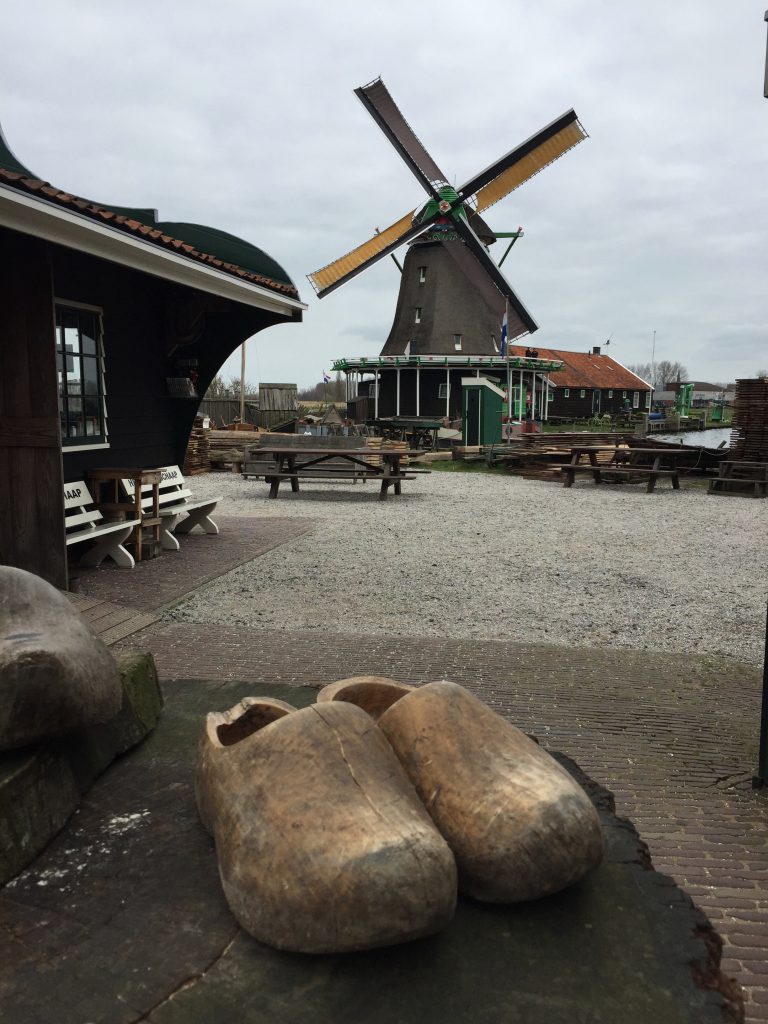
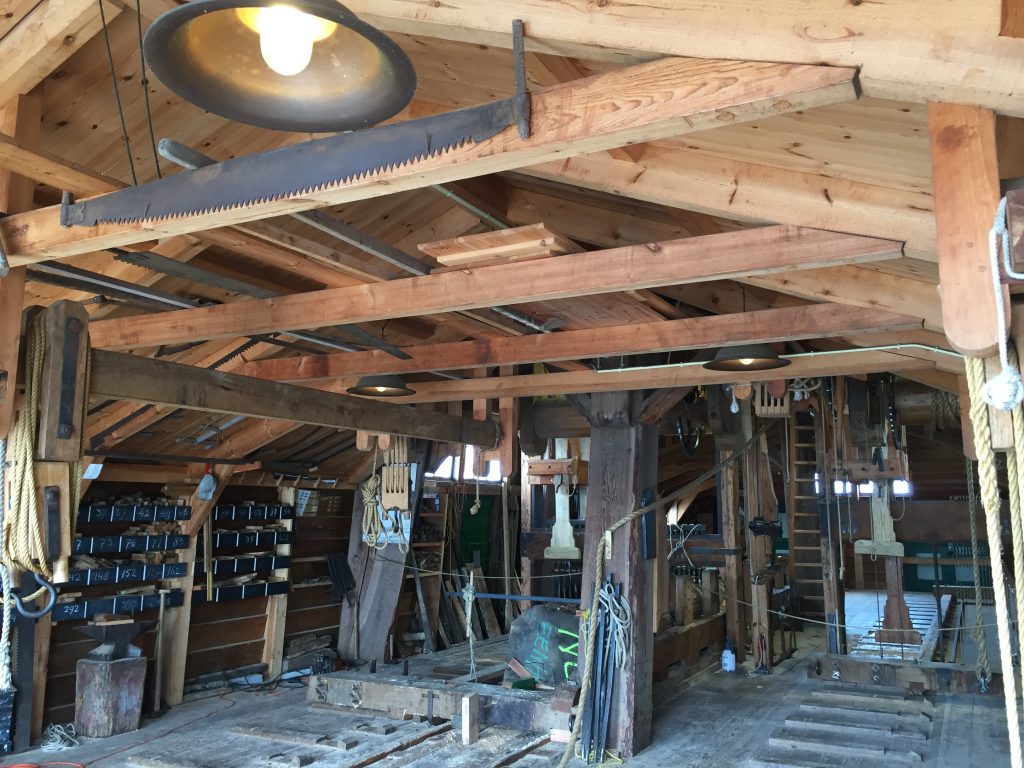
Inside the saw windmill 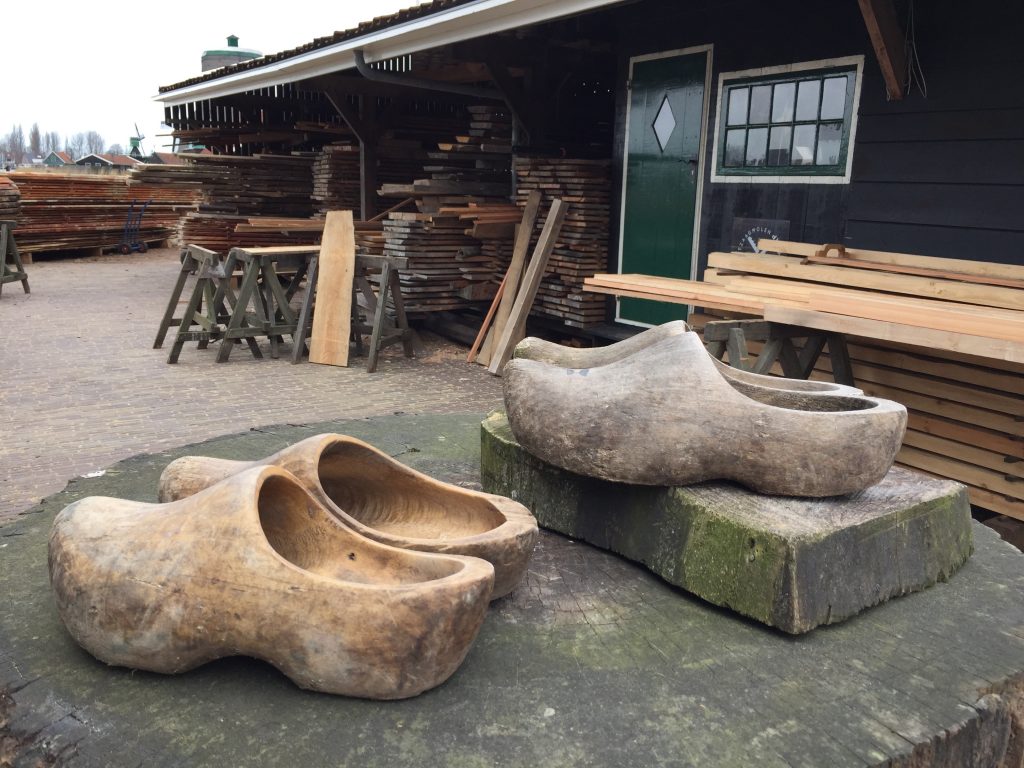
Clogs for giants 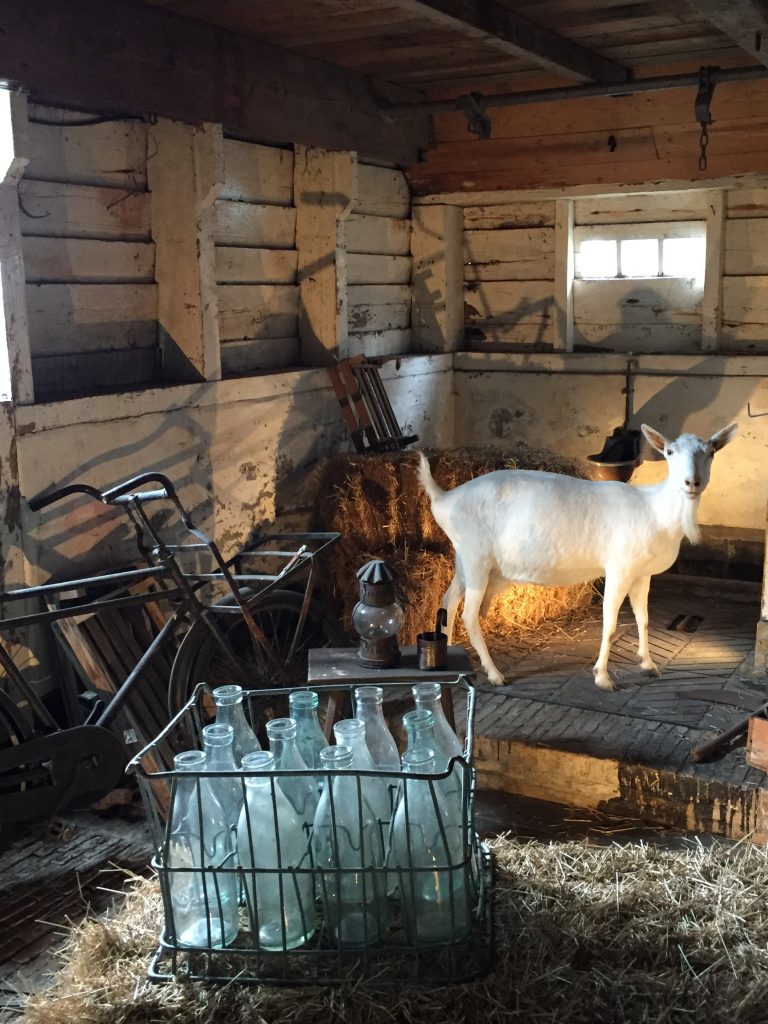
The cheese factory 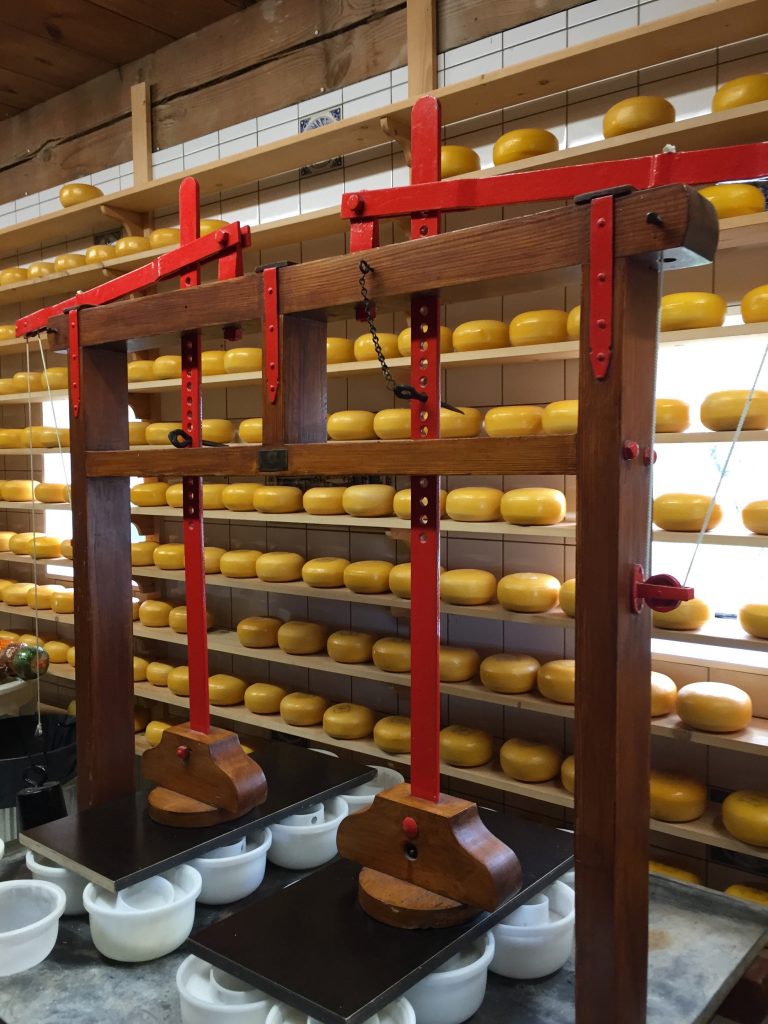
Gouda? Edam? 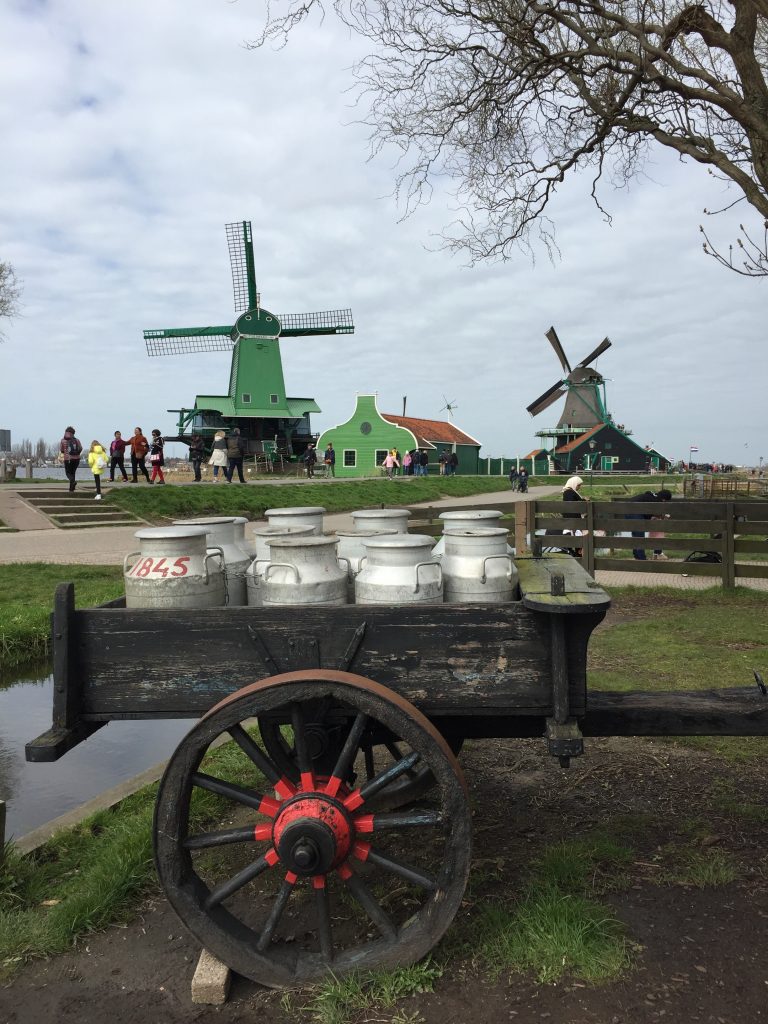
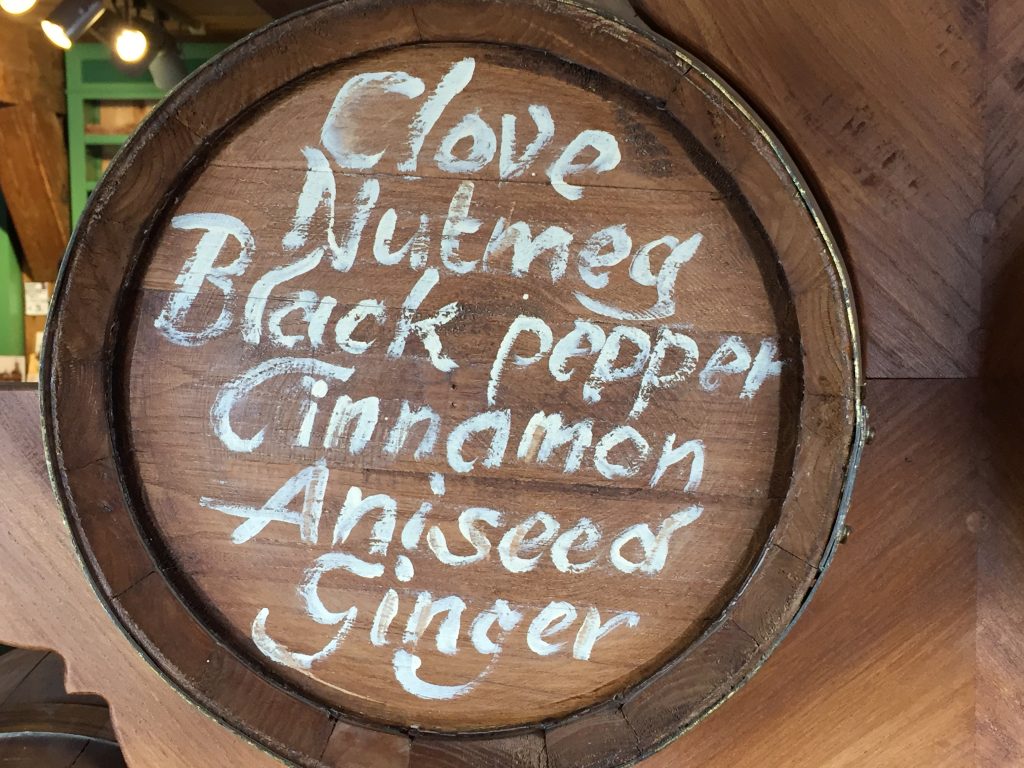
The spice windmill 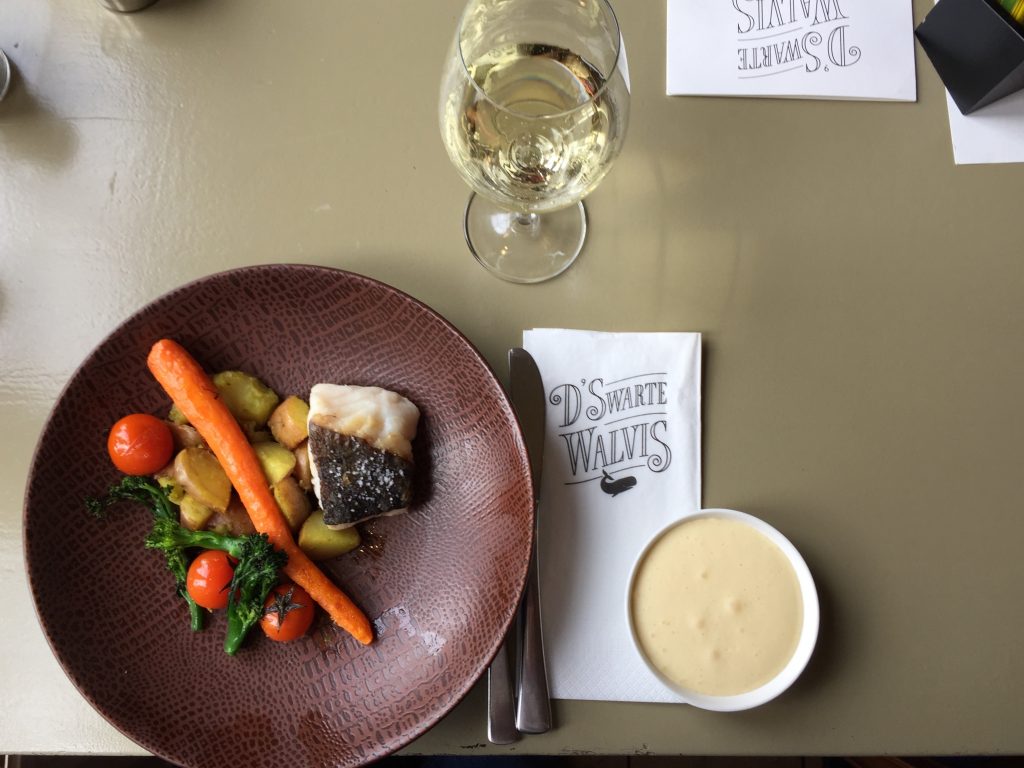
Yummy 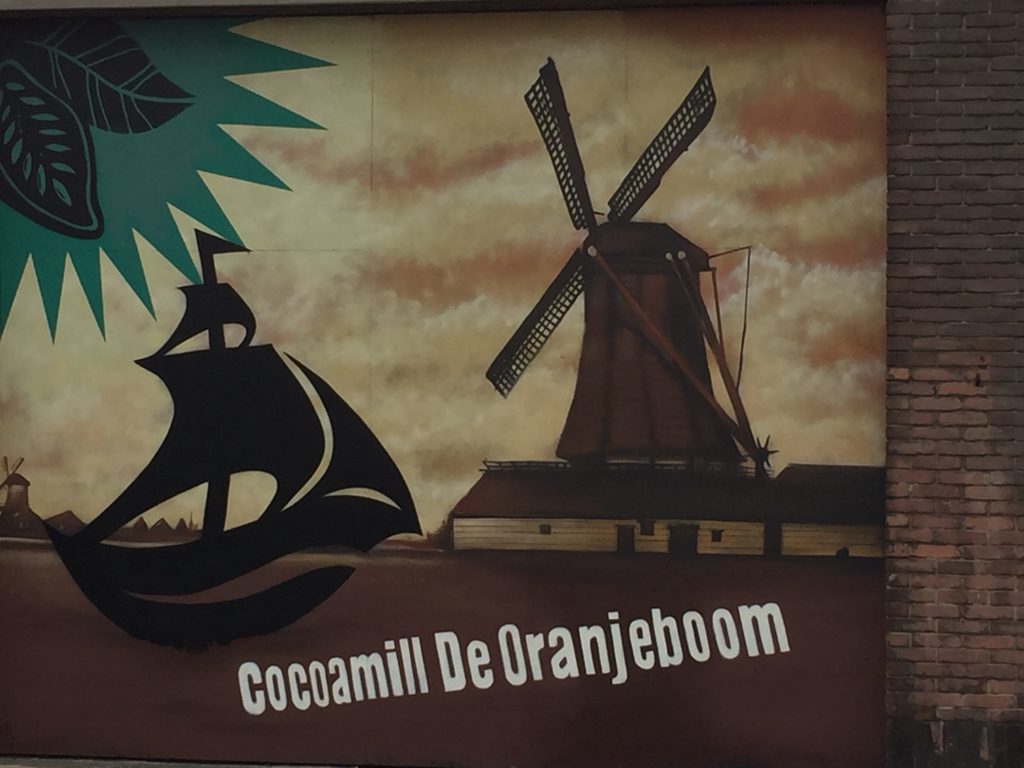
Smells like chocolate 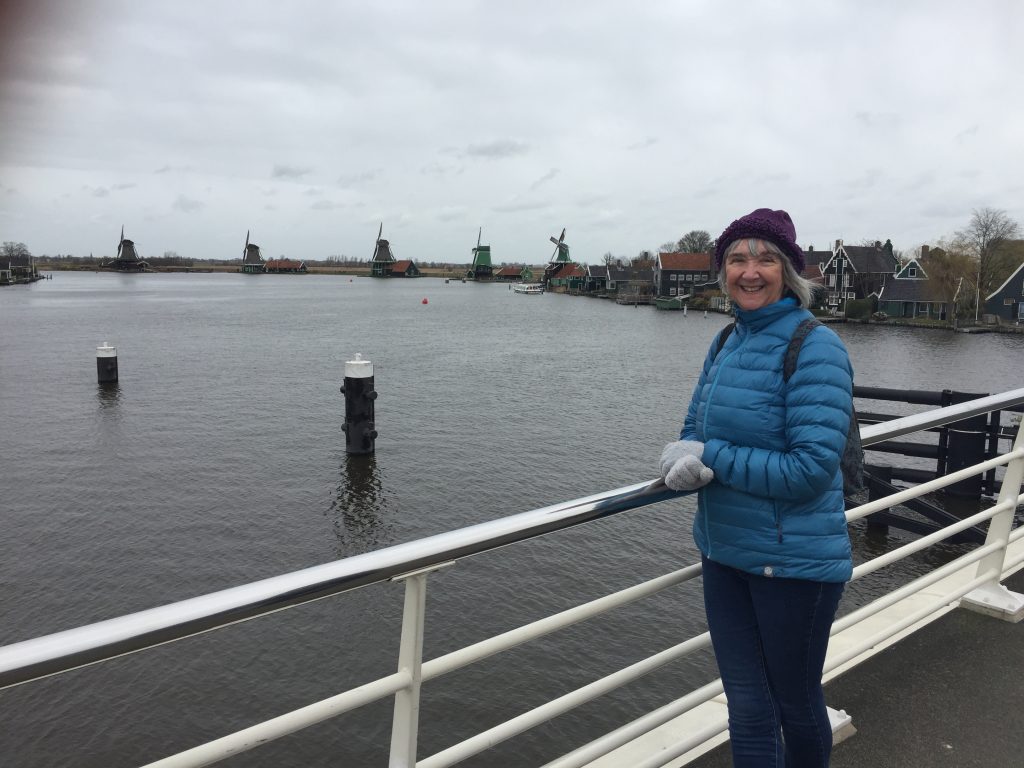
A cheese shop showed the cheese making process (something that I’d seen for the first time in Sicily last year) and the servers were dressed in traditional costume. We explored some of the local merchants’ houses, very pretty 17th to 19th century, with swans gliding along the small canals and then we had lunch in D’Swarte Walvis. 20 years ago it lost its Michelin star but at least that means it’s now within my price range. we had a lovely window seat and were occupied by watching workers preparing the gardens and courtyard for the upcoming summer season – power washing everything.
As we returned to the station we could smell chocolate coming from a large cocoa factory, another tradition of this region.
The gardens of Keukenhof were next on our itinerary. It had been overcast in Zaanse Schans but here at Keukenhof it was decidedly chilly too, and it felt a little weird to be wandering around these lovely gardens in such weather. In fact the gardens only opened a couple of days ago for the season so they probably weren’t looking quite their best. What I found quite lovely however, were the 6 or so buildings featuring amazing floral displays. Around 7 million bulbs are planted annually. It opened in 1950 in the grounds of a former castle dating back to the 15th century. The theme of this year’s displays is Flower Power and the displays were inventive, colorful and amusing at times. I particularly enjoyed the orchid building, and reading the names of the tulips. I tried to find names of people I know: I found a Marie Jo and a Danny – and Oracle! There was even a Pleyel piano bedecked with flower pots.
We headed back to Zaandam after a full day of beautiful colors and experiences, not to mention 8 miles of walking! We had dinner in a bar in Zaandam and were alarmed to find shards of glass on the table. We moved tables and were even more alarmed to find shards of glass on that table too! Walking back I noticed Tulip Vodka for sale – hmmm.
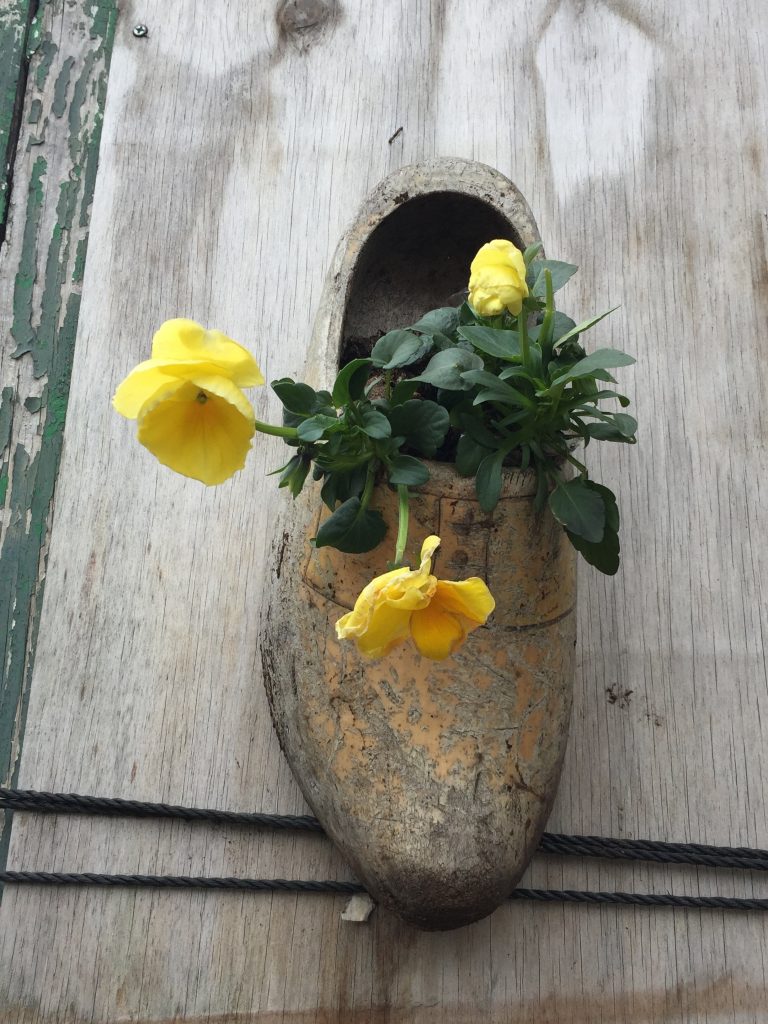

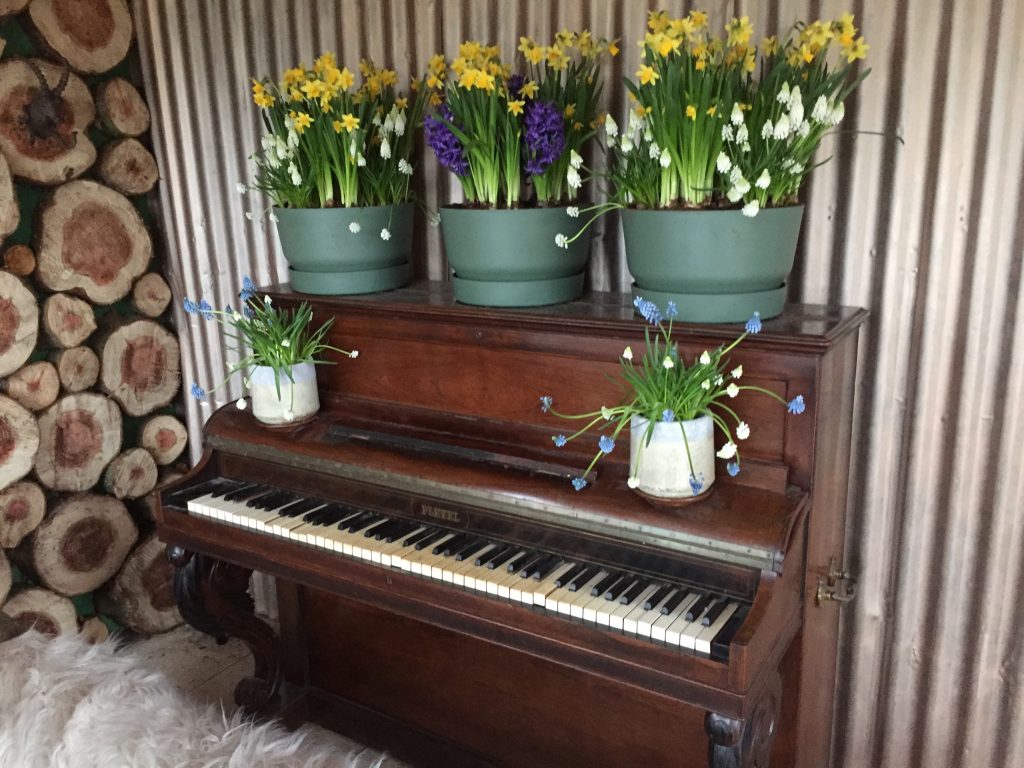
A Pleyel piano 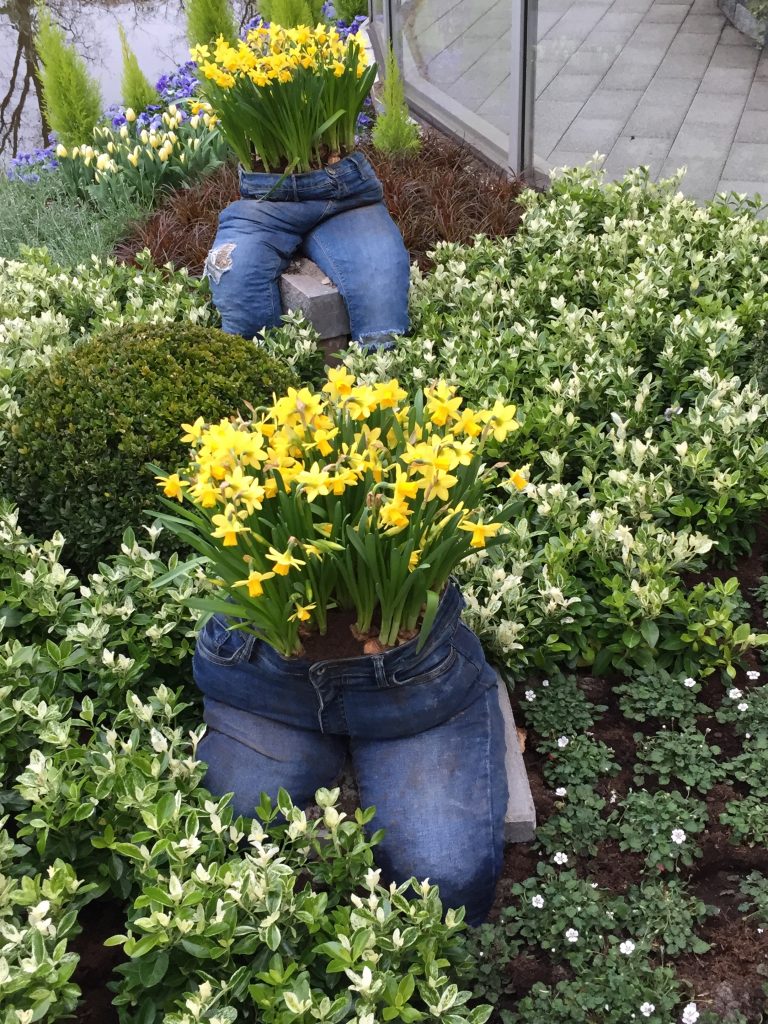

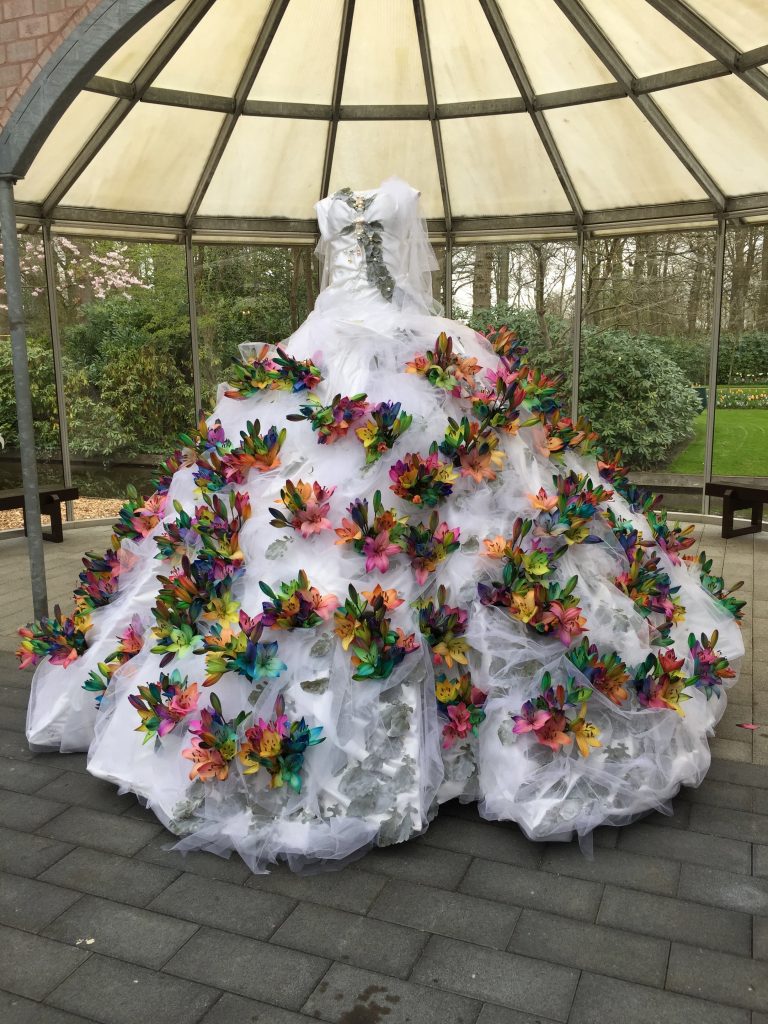

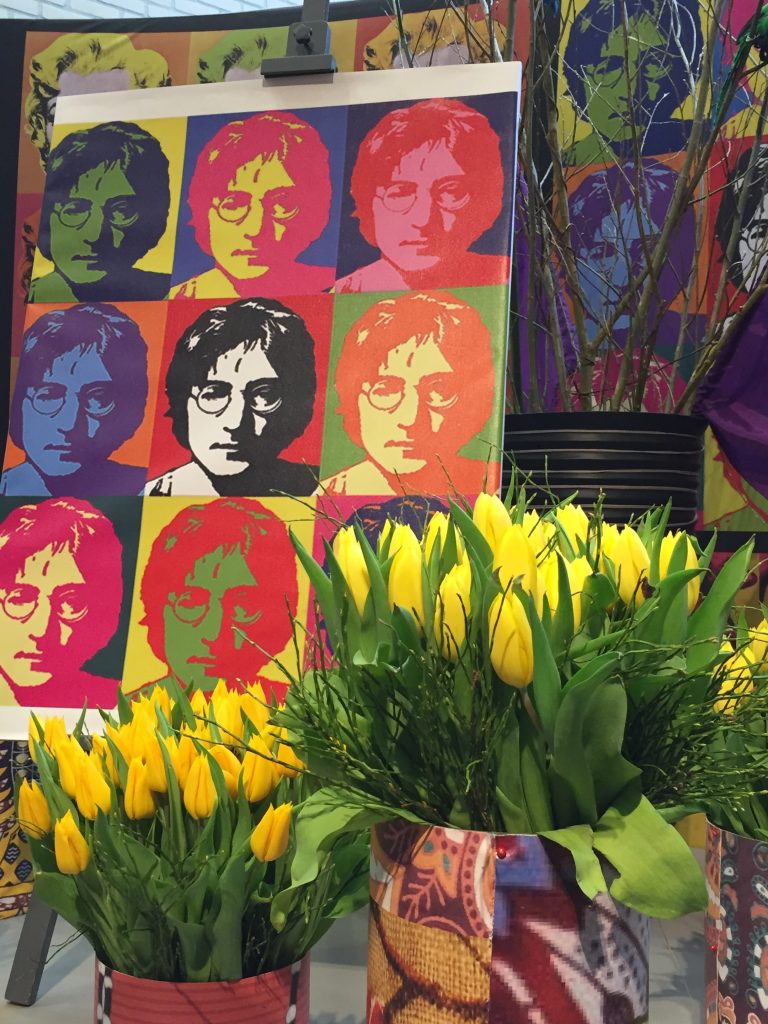
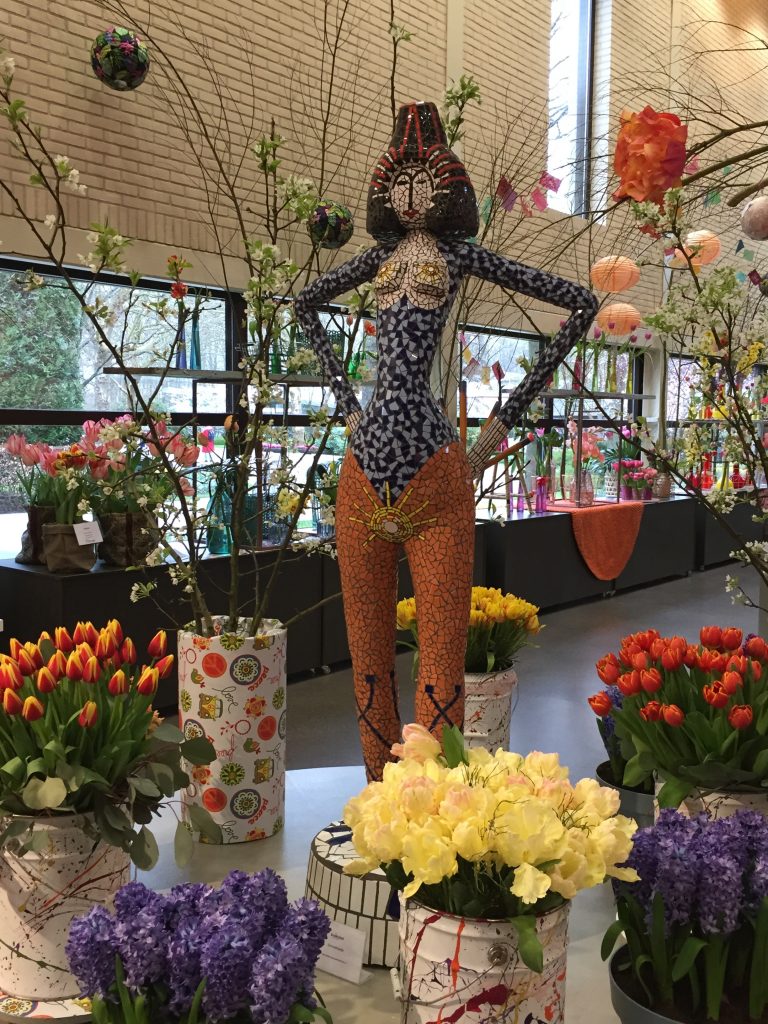
Flower power at Keukenhof gardens
DAY 4
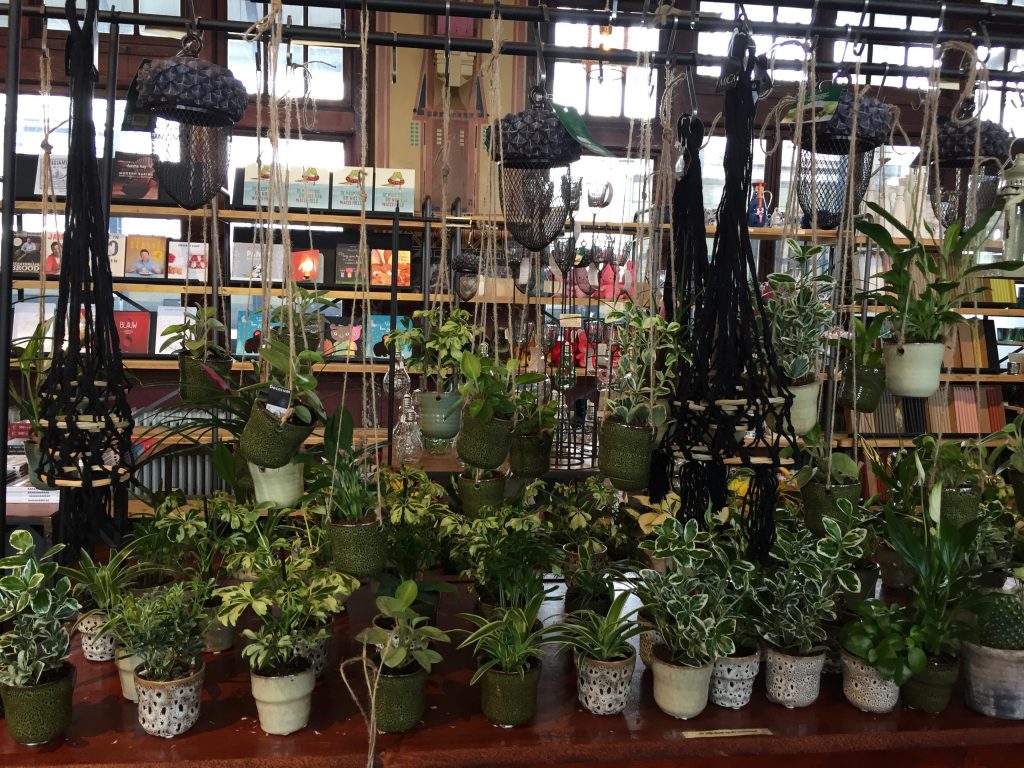
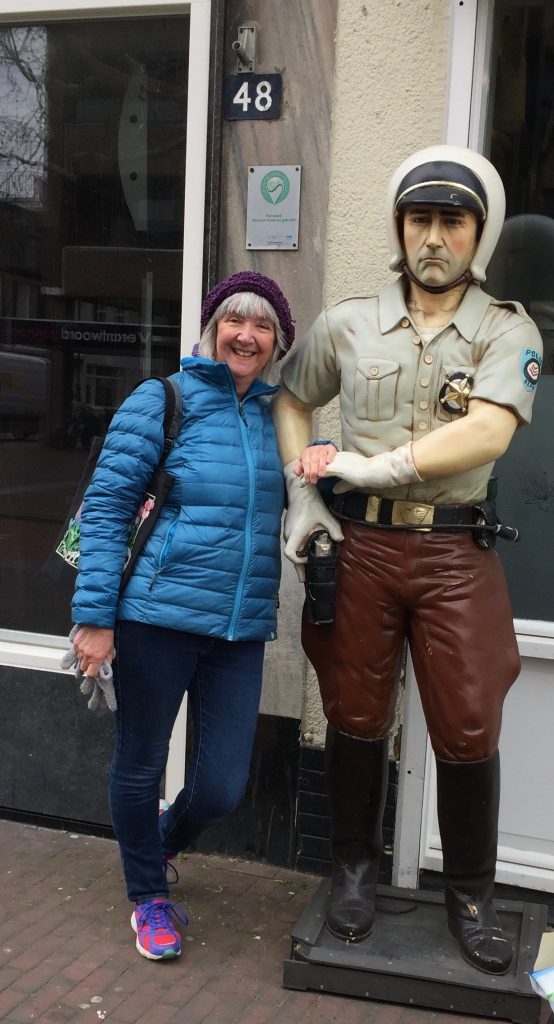
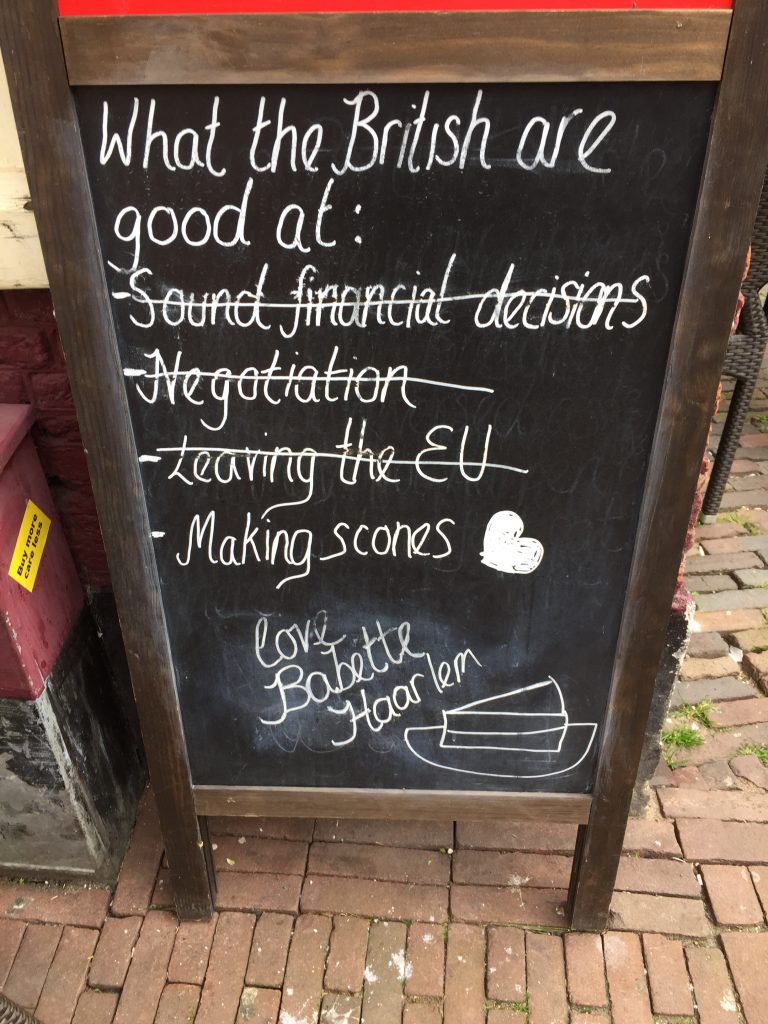
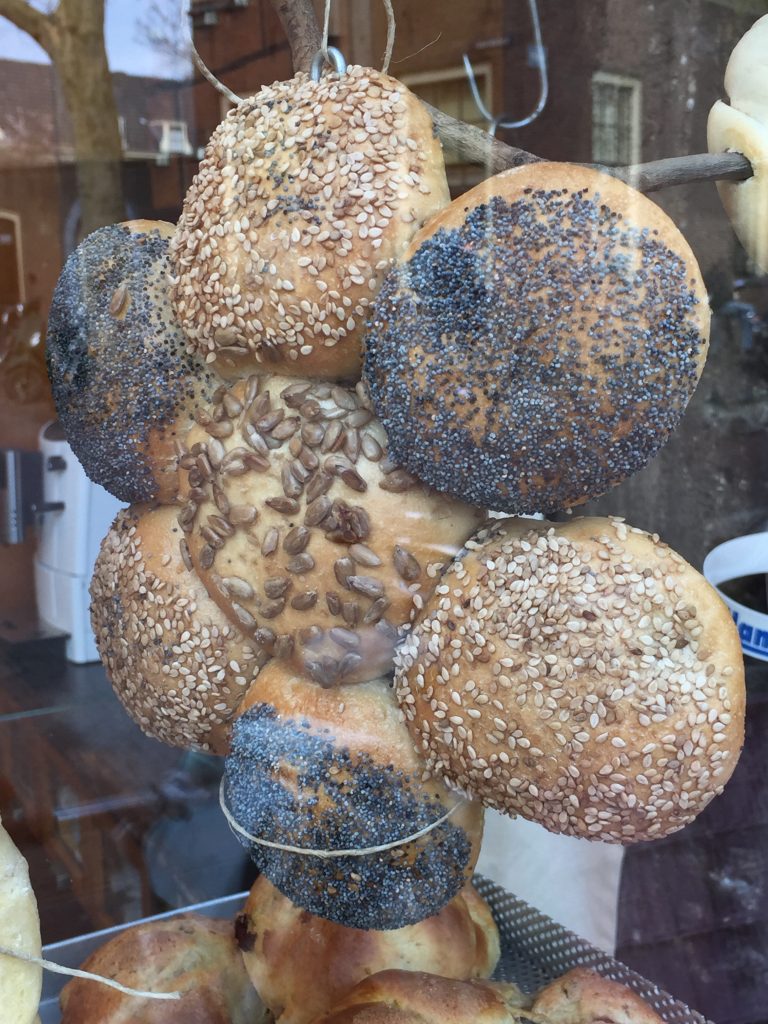
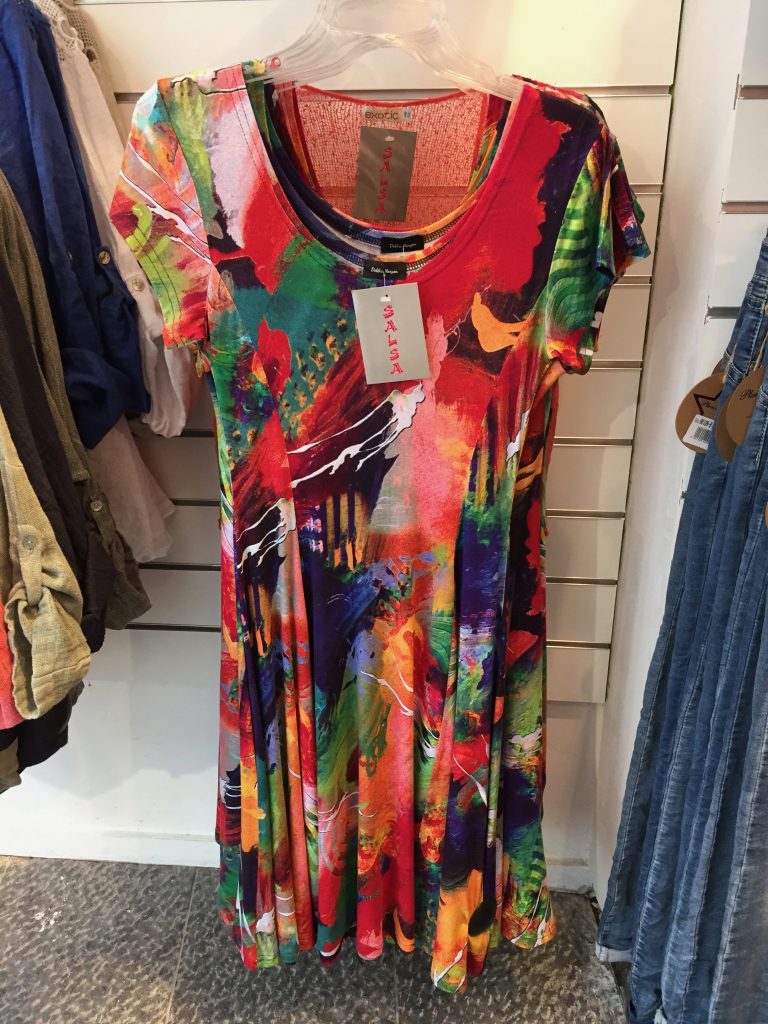
Dress for Sarah? 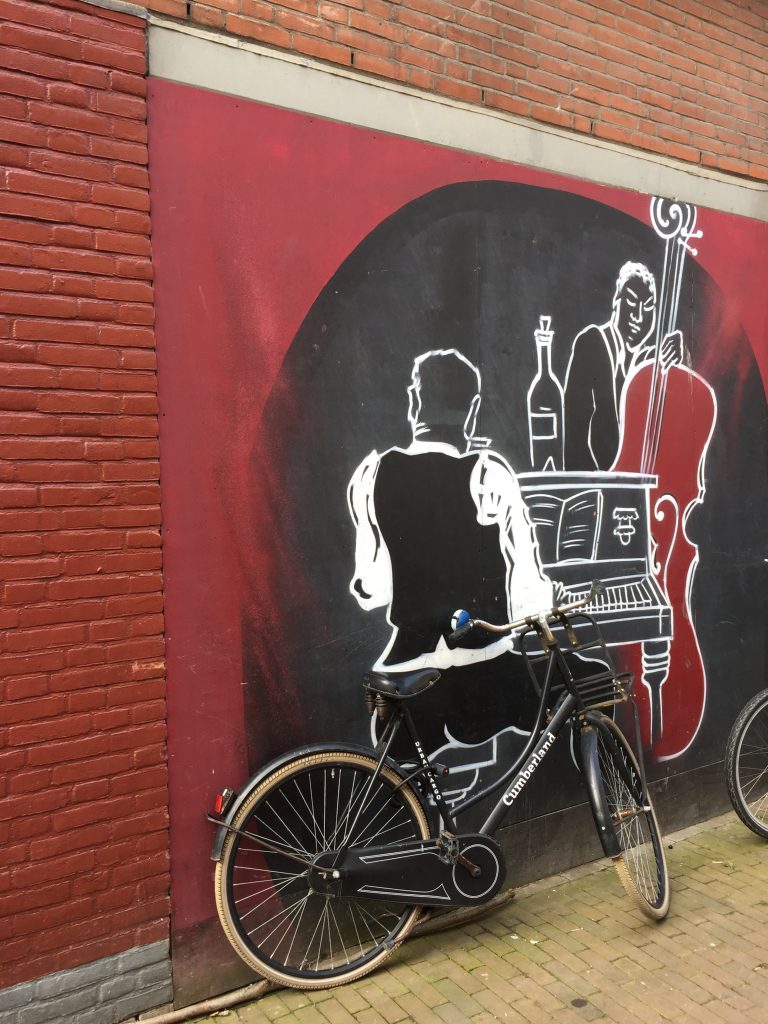
Graffiti in Spanish Haarlem
Haarlem was our destination this morning. The railway station had the most beautiful gift shop which, if my understanding of the Dutch sign above the entrance served me correctly, used to be the first class waiting room. But I was anxious to get my first glimpse of the city and we spent a lovely three and a half hours wandering the streets and taking in the sights. It seemed a more more approachable place than Amsterdam. Most of the bikes here were more like people carriers with carriages for children attached at the front. The window displays in the shops were incredible, and I thought of Paul McCartney whose goal in life was to be a window dresser! A bakery caught my eye, where the window was filled with suspended bread rolls. The entrance to a cannabis shop was guarded by a fierce, good looking policeman who posed with me for a photo! A boutique with brightly colored dresses invited more exploration and I found a dress that Sarah would have loved – every color! For myself I couldn’t resist buying a lacey pale blue shirt. it will look good with my newly purchased tulip socks and windmill earrings!!! The coffee shop that George Clooney advertises looked like no coffee shop I’ve ever seen before. I even found a variety called Arpeggio. Street art graffiti was tasteful, and reminded me of the colorful walls in Reykjavik. The town square is dominated by the Grote Kerk. The church is dedicated to St Bavo who died in 653AD. After fires damaged the original church the current church was built between 1370 and 1538. The organ was built by Christian Muller between 1735 and 1738 and underwent extensive renovation in the early 1960’s. It is a stunning piece of craftsmanship consisting of over 5000 pipes, 68 registers and is almost 30 meters high, but I wasn’t able to see the three manual organ console. Mozart played this organ when he was 10 years old and Handel played it too. There was quite a lot of modern art too, stained glass, sculpture, painting, reminding me of Blackburn cathedral, but here it complements the ancient artwork too.
For once it was warm enough to have lunch at cafe overlooking the square. I had a lovely Thai chicken skewer and a Belgian beer – delightful. Town squares and streets in general are set with bricks rather than macadam so that they don’t buckle with the dampness of the underlying soil. A line of espalier trees provided resting places for birds but I’m glad our table wasn’t directly beneath!

Next we were off to the seaside – or Overveen – Amsterdam’s beach. It didn’t take long to get there by bus and we were lucky that the weather was so good. Beautiful blue sky and a long almost deserted beach to explore. Thousands of razor shells were washed up and walking on them made a wonderful scrunchy sound. We could see high rise buildings of Zandvoort in the distance through the sea mist.
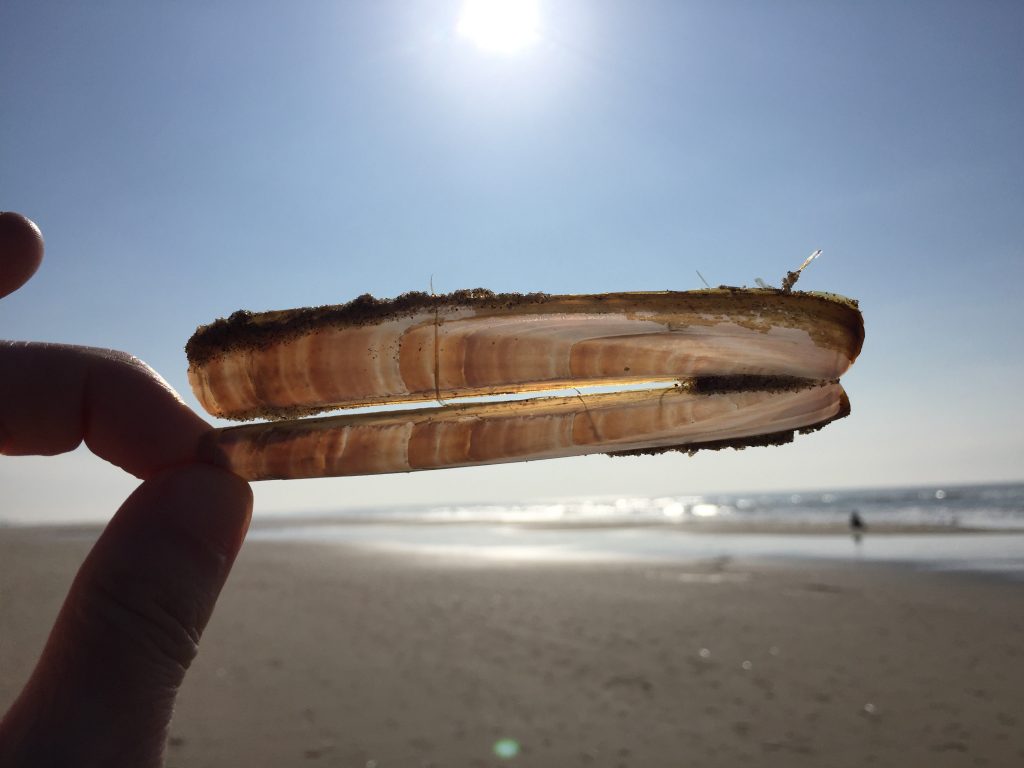
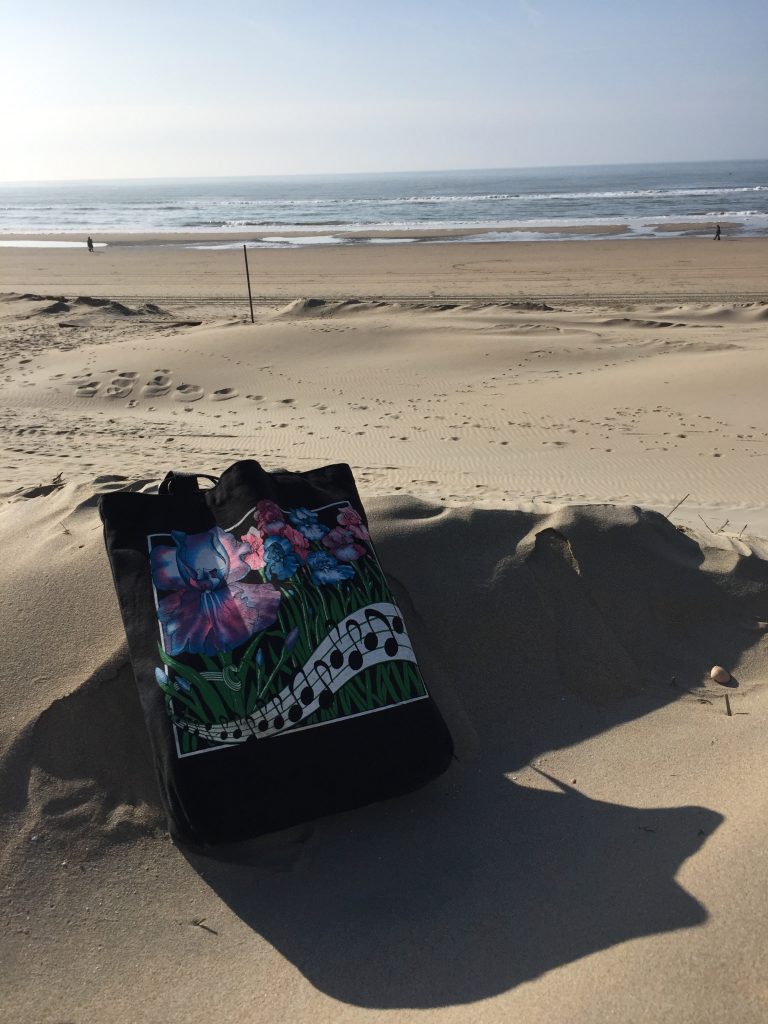
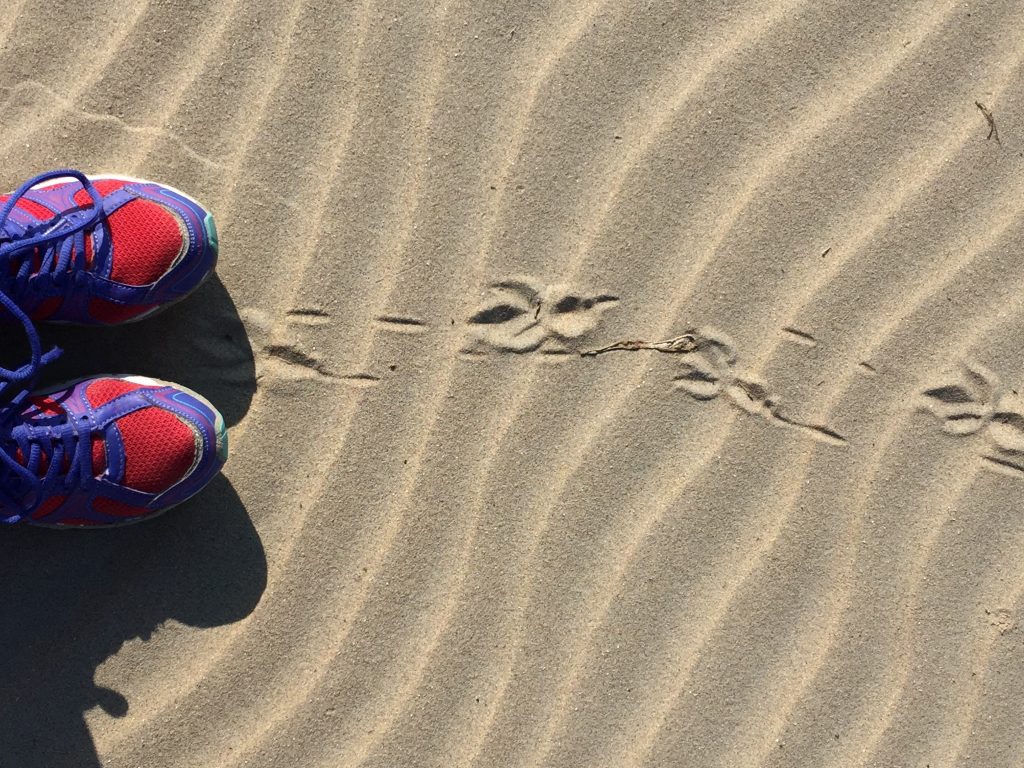
Back in Amsterdam we were bound for an hour and a half’s cruise on the canal. I was anxious that we too late in the day for good light for taking photographs but it was fine. Occasionally we passed by a gap in the rows of merchants’ houses and the low sunlight was able to skim the canal surface – very pretty. I elected not to listen to the running commentary on the headset and just soak in the picture in front of me – beautiful. We passed the dock where the Viking river boat cruise liners dock. They are huge! In the Amstel district we saw the row of houses called the Dancing Ladies because they are now situated at rather weird angles as they sink into the wet soil. Yet all these picturesque houses are immaculately maintained. Apparently there’s a city ordinance requiring this.Also in the Amstel district is the modern opera and ballet hall, built onto the canal, its location and architecture again reminding me of Reykjavik.
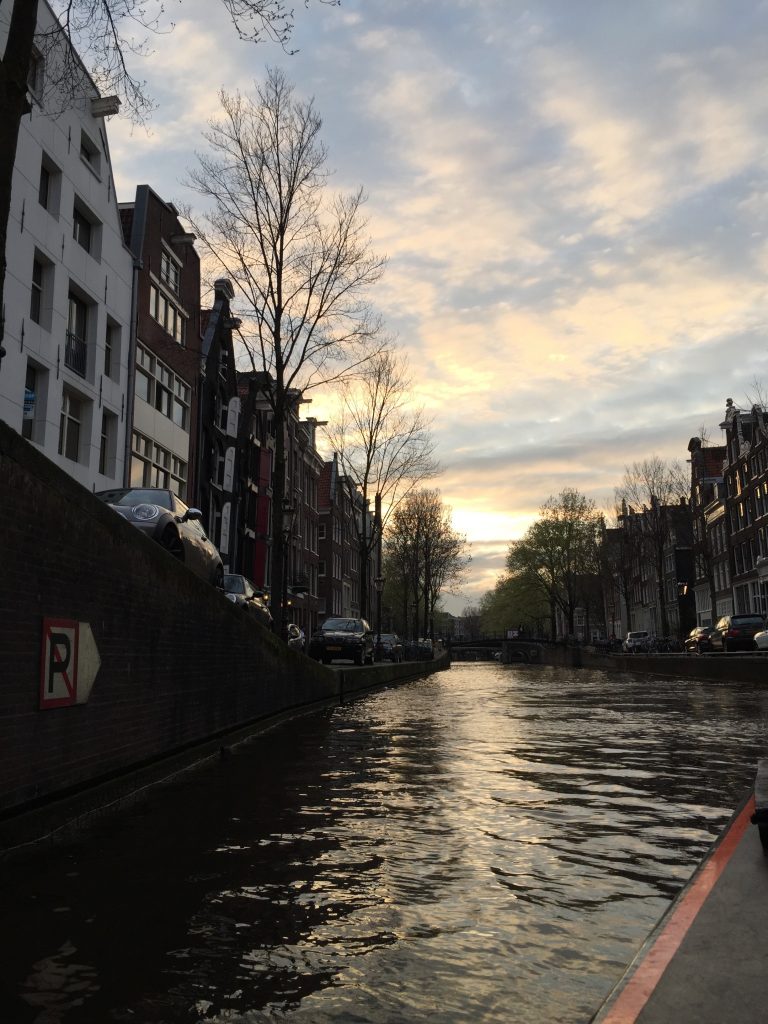
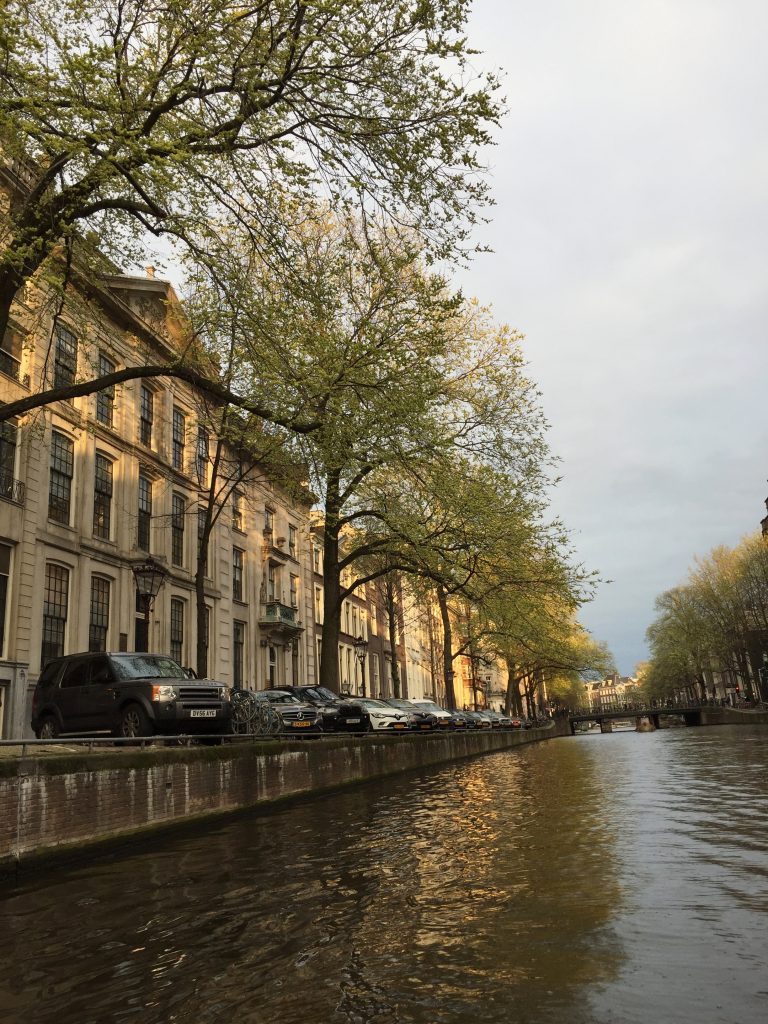
It was getting dark by the time our cruise was complete and we headed to the Red Light district which was busy with people my age eager to see what the fuss is all about. The sex toy shops were doing a roaring business. I expected seeing scantily clad girls beckoning guys into the blue movie houses or girls posing seductively in red lighted windows as was the case in Brussels. Perhaps it was just too early in the evening.
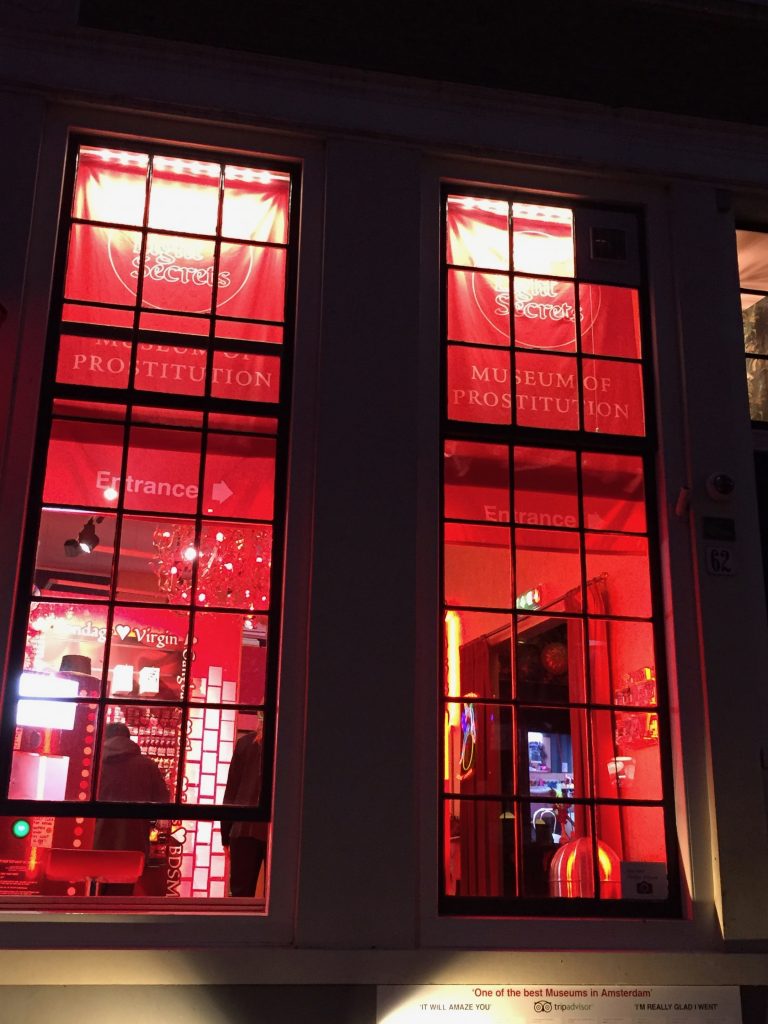
Back in Zaandam we tried to ‘go Thai’ but the restaurant didn’t look particularly inviting (lighting makes such a big difference to the ambiance of a place) so we ended up at the nice Italian place for a second night, hungry after another full day of sight seeing and walking 8 miles.
DAY 5
We had planned to spend the morning exploring more of Zaandam before our mid afternoon flight home. I began the day by trying to find postage stamps for the postcards I’d written. This was easier said than done. The first concierge I spoke to didn’t know where I could buy stamps. The second suggested I try the supermarket. No luck there, but a helpful assistant suggested I should try the bookstore. Hmmm. So I set off in search of the book store. Success. Then I asked where I could post my postcards sporting their new stamps. “Ah,” she said, “You need to go to another book store.” This time her instructions of how to locate the bookstore with the mail box was less than accurate, but at least I was having a good time exploring the streets of Zaandam. Having given up and retraced my steps I found the bookstore and, hey presto, there was even a mail box for my postcards!
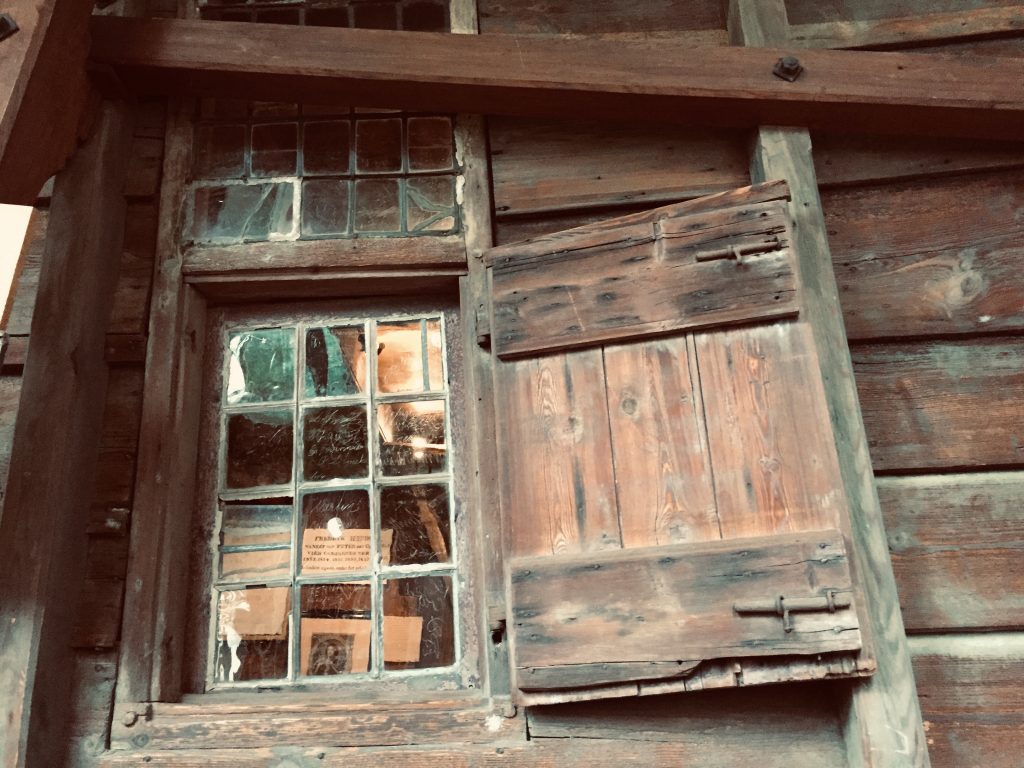
Next was a visit to Tzar Peter’s house, one of the oldest buildings in Holland. This is the building in which Tzar peter de Grote stayed in 1697. he came to Zaandam in order to learn the trade of ship building. At the time Russia was a country that was way behind the Netherlands in its industry, exploration of the world, and transportation and so Tzar Peter came, incognito, to learn the shipwright’s trade. Incognito was difficult for him because he was 6’8″. The Russian tzars and Dutch monarchs realised that the house needed protection from the elements and in the 19th century a building was built around the wooden house to protect it.
A death mask of Tzar Peter is on display. The windows are completely covered in scratched signature spanning several centuries, and the subsidence causes everything to learn at a precarious angle. it was a great place to take photos and since there were only another couple of people touring the site I was able to take lots of pictures. The were even bottles of Russian Imperial stout for sale, named, of course, Czar Peter.
Back in the town centre I had half an hour to wait for the rest of the group so I indulged myself at a lovely cafe, which was named an ‘American’ cafe. the deserts looked amazing , and I was disappointed that this was the wrong time of day for such extravagance! Still, the place provided me with the best cup of tea on the trip.
Our next port of call was the Monet Atelier located in a house right above the canal. Monet lived for 4 months in Zaandam in 1871 and painted 25 works. He was just in time to capture the old Zaandam, the one that I’d pictured in my mind. The Industrial Revolution, which had taken hold throughout most of Europe, and the advent of the steam engine, would within a few years irrevocably change the characteristic landscape of the Zaandam area, dotted with windmills, as Monet saw it. The small building contains replicas of all 25 paintings and its wonderful to see these all gathered in one small room, when, in actual fact, they are scattered around the world in museums and private collections.
It was time to set off on our journey home and our flight was delayed an hour but Schiphol airport is not a bad place to spend a little extra time. The flight was only 45 minutes and we landed in a lovely sunlit Yorkshire. I took the bus to the centre of Leeds passing Kirkstall Abbey. Perhaps it warrants a day out now that I know it’s quite reachable by public transport. From Leeds a train took me back to Hebden Bridge where I called in at the Chinese to take home some dinner.
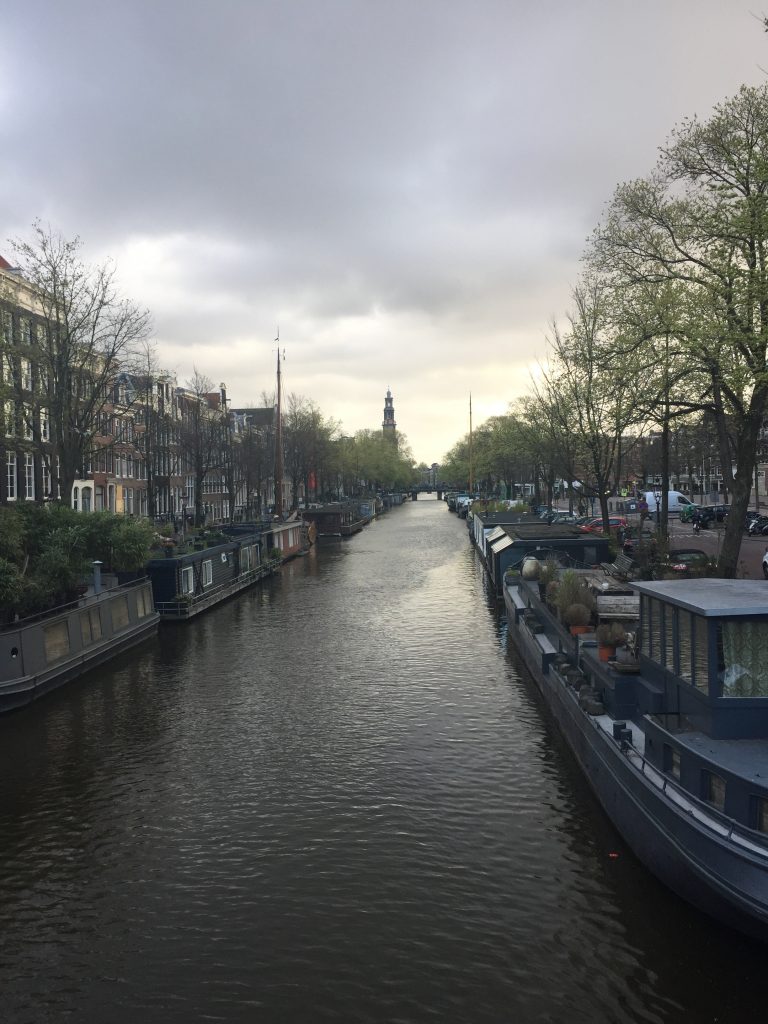
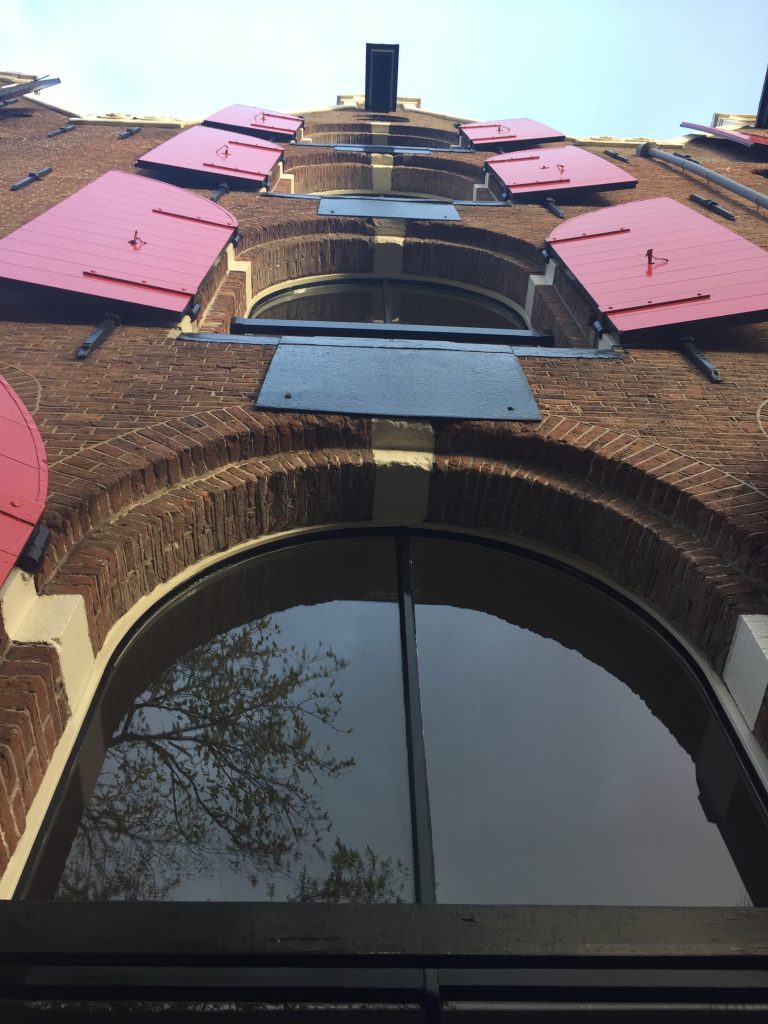
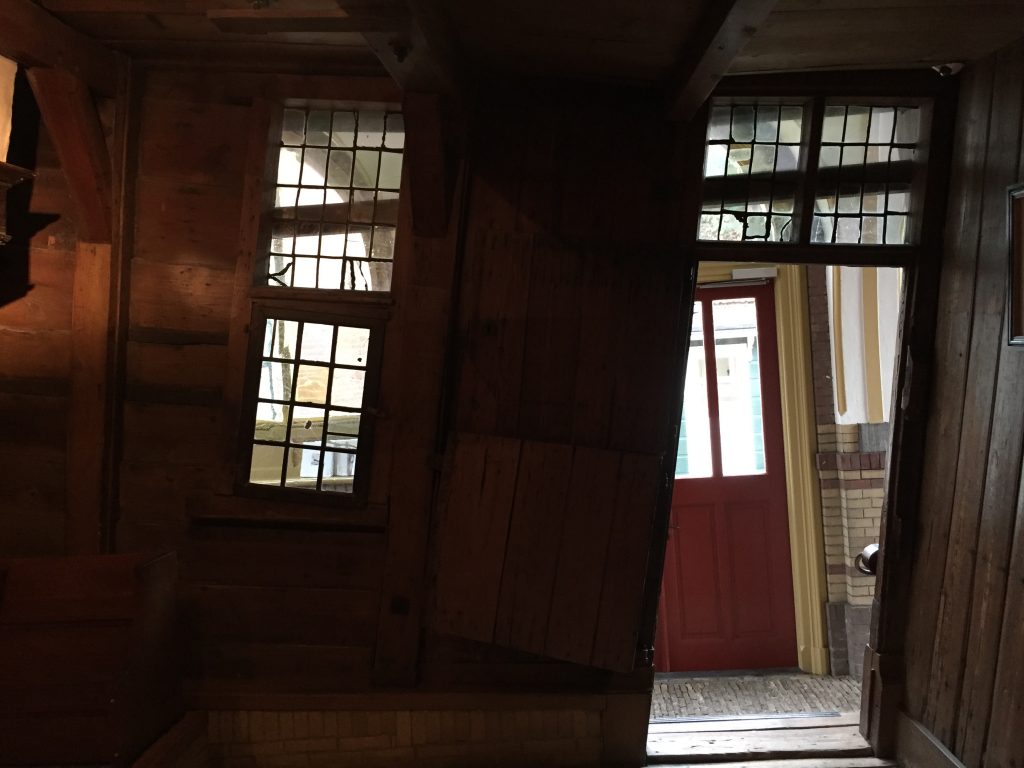
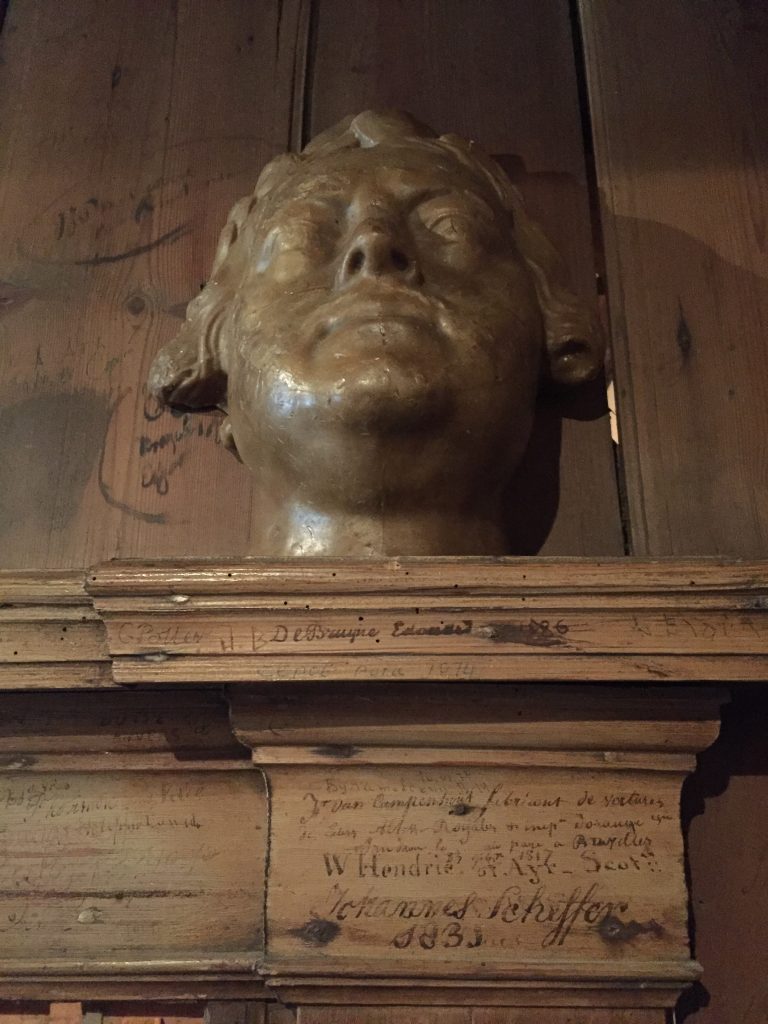

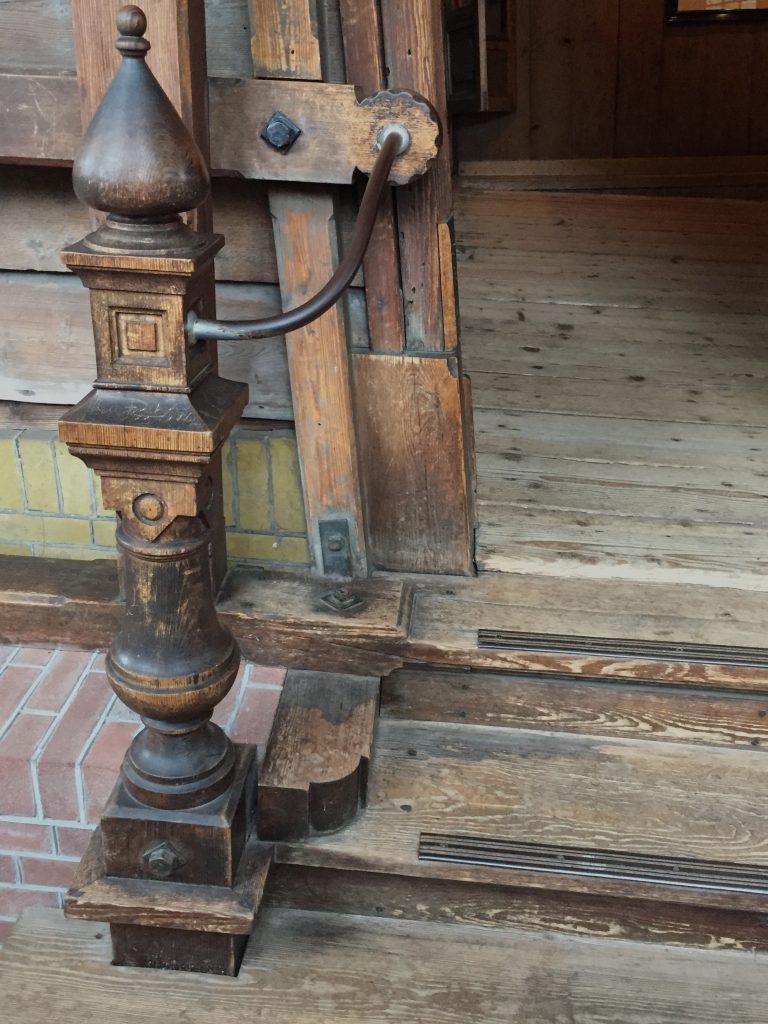
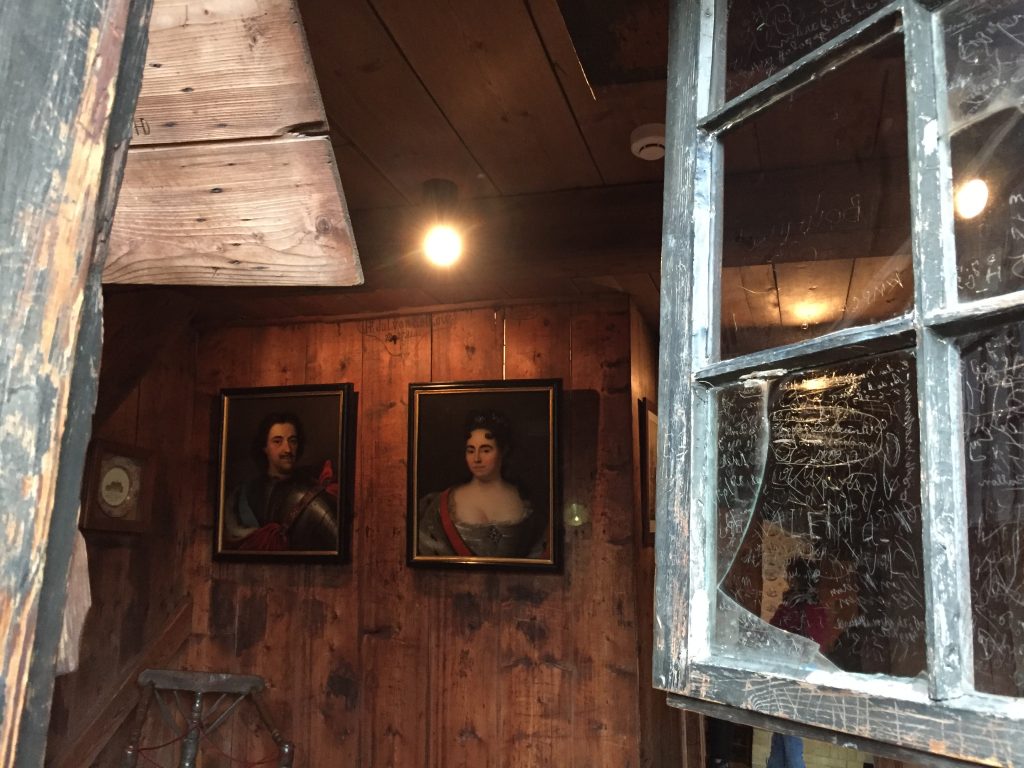
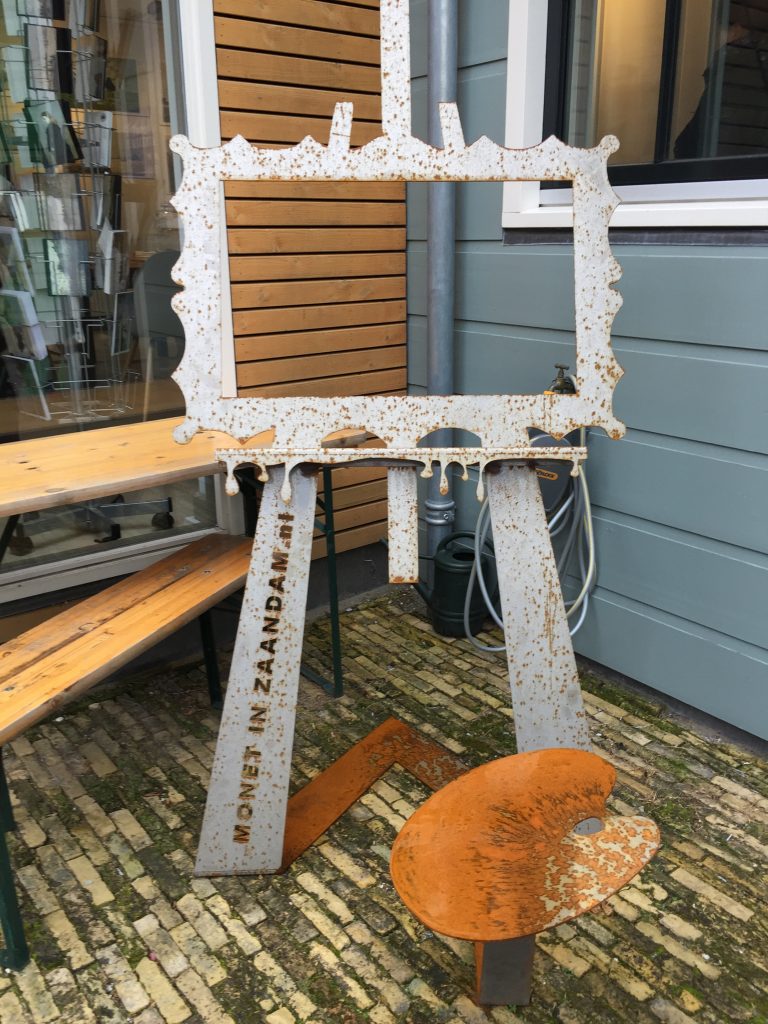
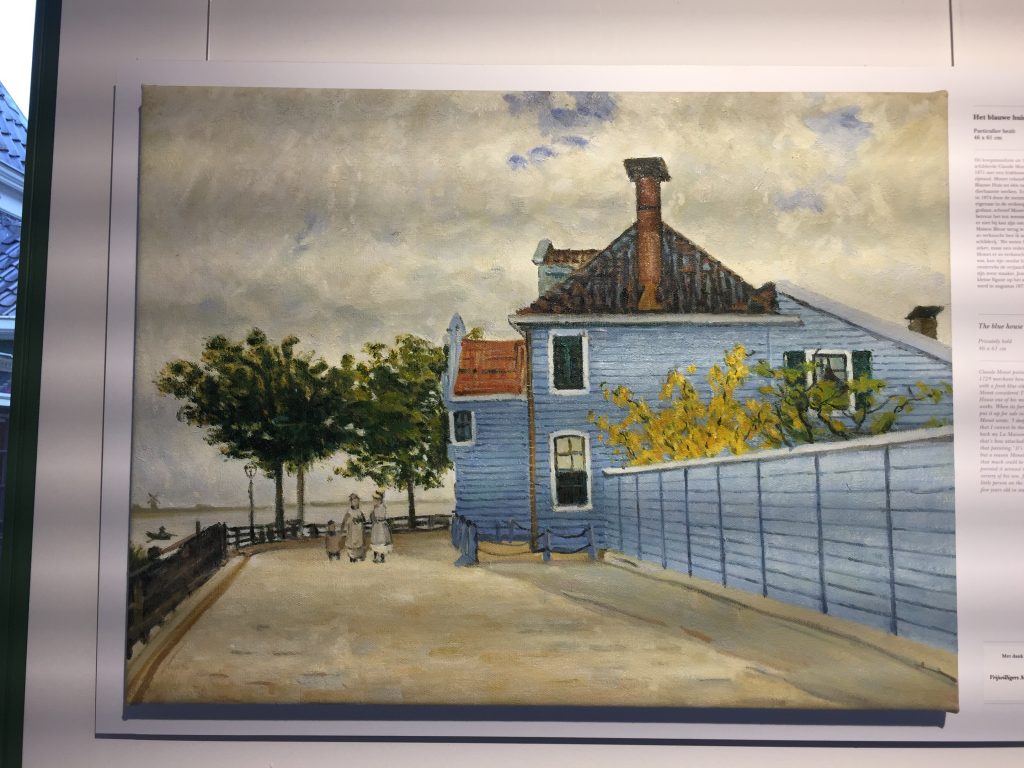
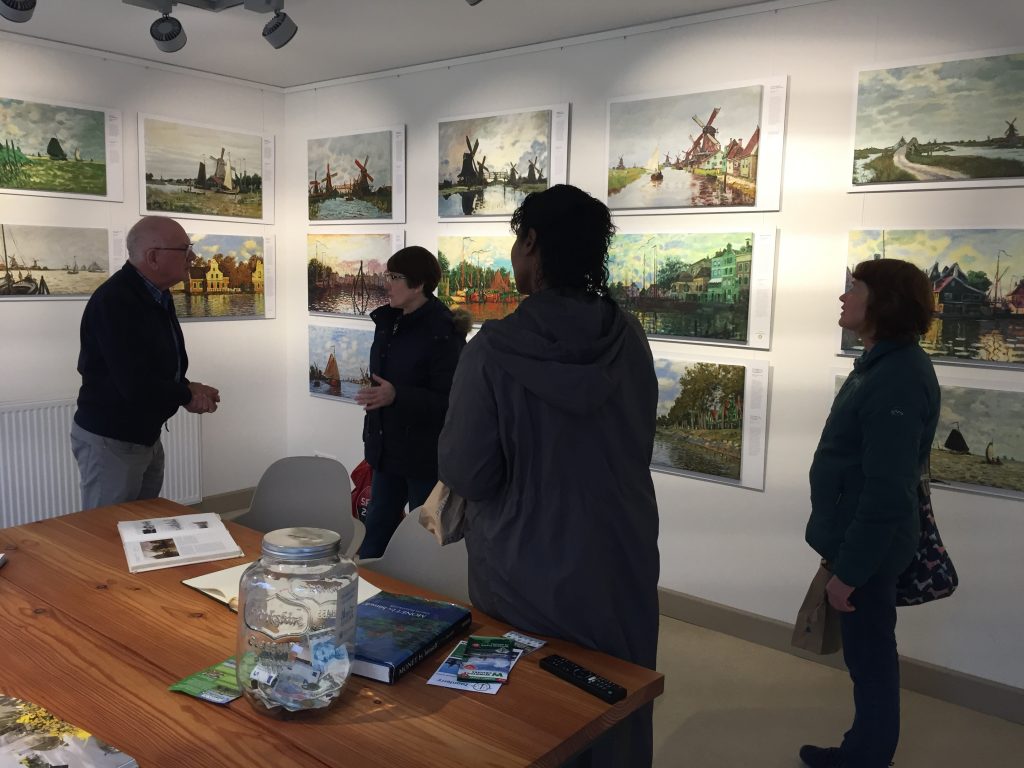
Recent Comments